The pandemic is killing thousands daily, crushing India’s modest health system, causing crippling shortages of doctors, nurses, medicines, even oxygen. If last week witnessed Narendra Modi government’s biggest crisis, it’s only become bigger since.
The second wave of Covid-19, with the spiraling cases and deaths across cities and towns, making India currently the world’s worst pandemic-affected country, have now dented India’s Prime Minister Narendra Modi’s image in India and around the world for the poor vision, poor planning, and mismanagement of the most deadly virus in over a century.
The pandemic is killing thousands daily, crushing India’s modest health system, causing crippling shortages of doctors, nurses, medicines, even oxygen. If last week witnessed Narendra Modi government’s biggest crisis, it’s only become bigger since. It threatens to grow bigger over the next several weeks, healthcare experts say.
With over 350,000 new coronavirus cases daily and more than 2,000 people dying every 24 hours, the situation has become too tumultuous for Modi, the leader of Hindutva or Hindu nationhood. The daily increase in cases has forced many Indians to raise their eyebrows about the governance efficiency of Modi, hitherto considered the superhero and a catalyst of good governance.
Modi’s government has faced criticism that it let its guard down, allowed big religious and political gatherings to take place when India’s cases plummeted to below 10,000 a day and did not plan on building up the healthcare systems. Hospitals and doctors have put out urgent notices that they were unable to cope with the rush of patients.
India’s total tally of infections stands at 16.96 million and deaths 192,311 after 2,767 more died overnight, health ministry data showed. In the last month alone, daily cases have gone up eight times and deaths by 10 times. Health experts say the death count is probably far higher.
India’s surge is expected to peak in mid-May with the daily count of infections reaching half a million, the Indian Express said citing an internal government assessment. V.K. Paul, a COVID-task force leader, made the presentation during a meeting with Modi and state chief ministers and said that the health infrastructure in heavily populated states is not adequate enough to cope, according to the media reports.
The Guardian, a popular Western publication wrote in an editorial this week: “At the beginning of March, the Hindu nationalist government of Narendra Modi claimed the country was in Covid-19’s “endgame”. India is now in a living hell. A new “double mutant” variant, named B.1.617, has emerged in a devastating coronavirus second wave which has seen hospitals run out of beds and oxygen. Mortuaries are so full that bodies are justify to decompose at home. Charities warn that the dead risk being justify on the streets.”
The second wave of cases has been made more deadly by oxygen shortages in hospitals. An investigation by Indian news website Scroll.in revealed that the country’s government waited until October 2020, eight months after the pandemic began, to invite bids for a $27 million contract to place oxygen generation systems inside more than 150 district hospitals. Six months later, most still aren’t up and running. Several states across the nation have expressed despair as most hospitals have run short of Oxygen.
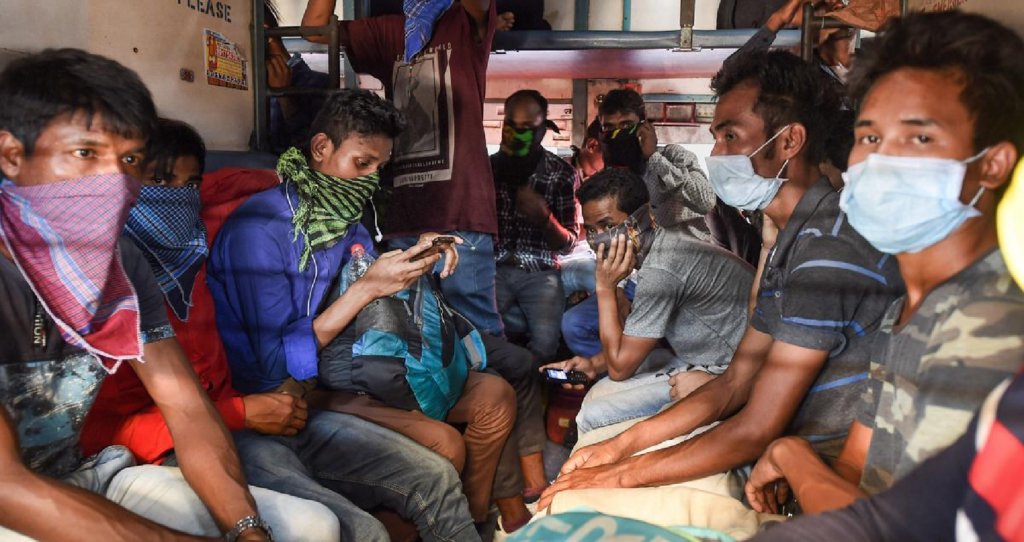 “India is in the ICU and those who put her there now spend their time trying to shift the blame. The change from ‘victory’ over Covid to gasping for oxygen began in the last week of January this year when the Prime Minister proudly declared that India had not only defeated the pandemic but had been an inspiration for other countries. He then proceeded to personally oversee vaccine exports to needy countries and his Minister of External Affairs boasted about it. After this ‘victory’, the Prime Minister and Home Minister spent their time organizing a blitzkrieg of election rallies in West Bengal and Assam without wearing masks and while exhorting large crowds to gather,” wrote columnist Tavleen Singh in The Indian Express.
“India is in the ICU and those who put her there now spend their time trying to shift the blame. The change from ‘victory’ over Covid to gasping for oxygen began in the last week of January this year when the Prime Minister proudly declared that India had not only defeated the pandemic but had been an inspiration for other countries. He then proceeded to personally oversee vaccine exports to needy countries and his Minister of External Affairs boasted about it. After this ‘victory’, the Prime Minister and Home Minister spent their time organizing a blitzkrieg of election rallies in West Bengal and Assam without wearing masks and while exhorting large crowds to gather,” wrote columnist Tavleen Singh in The Indian Express.
If you’ve been tempted to think the pandemic is over, journalist Rana Ayyub’s reporting from India will prove you sorely mistaken. “If the apocalypse had an image,” she writes for TIME, “it would be the hospitals of India.” India’s sheer volume of cases is contributing to that unimaginable death toll, but there are extenuating factors, too. Oxygen supplies are running out across the country, in part because the Indian government waited until October 2020 to seek contracts for installing oxygen generation systems in many hospitals, Ayyub reports. Some are still not working today, leaving critically ill patients without the thing they need most as their lungs fail.
A recent story in TIME magazine titled, “’This Is Hell.’ Prime Minister Modi’s Failure to Lead Is Deepening India’s COVID-19 Crisis” pointed out how India has mismanaged and sent misleading messages. “The Uttarakhand chief minister declared on March 20, “nobody will be stopped in the name of COVID-19 as we are sure the faith in God will overcome the fear of the virus.” It wasn’t until mid-April that Hindu nationalist Prime Minister Narendra Modi tweeted that participation in the pilgrimage should be kept “symbolic” to combat the pandemic. Is it any wonder that the festival has become a super-spreader event?”
But the statement by Modi came too late. Mega political rallies in poll bound states, led by Modi himself and his party leaders in several states has been stated to be instrumental in spiking the covid cases across India. Hundreds of thousands of Hindu devotees showed up each day for a dip in the Ganges as part of the Kumbh Mela pilgrimage in Haridwar, Uttarakhand. Millions of worshippers have participated in the weeks-long festival since the first day of bathing on March 11, despite clear evidence that thousands are testing positive for the virus after attending. In the space of just a few days in mid-April, more than 1,600 cases were confirmed among devotees. In March, when the second wave was already underway, state leaders from the ruling Bharatiya Janata Party (BJP) published full-page ads in national newspapers telling worshippers it was “clean” and “safe” to attend.
Last week, as India reported the highest number of daily cases of anywhere in the world, the ruling Bharatiya Janata Party tweeted a video of one of Modi’s political rallies. Alongside Modi was his close confidante and home minister, Amit Shah. In theory, Shah should have been in the capital, coordinating with various state governments on how to deal with the devastating spike in COVID-19 cases over the past few weeks. Instead, Shah has been holding roadshows with thousands of joyous crowds on the streets of West Bengal which is in the midst of elections to the state Assembly. “Since January, Modi has organized mass political rallies in various states and has allowed religious events like the Kumbh Mela to go ahead, while his party continued with its dog-whistle campaigns against Indian minorities,” TIME reported.
The Guardian wrote: “Like Donald Trump, Mr Modi would not give up campaigning while the pandemic raged. India went ahead with five state elections in April, and an unmasked Mr Modi held huge rallies. Mr Modi’s brand of Indian exceptionalism bred complacency. A presumption of national greatness has led to a lack of preparedness, most notably in vaccine production.”
“The country has been too complacent and relaxed for too long. Now we are paying the price for that negligence,” Archbishop Prakash Mallavarapu, chairman of the Healthcare Commission of the Catholic Bishops’ Conference of India (CBCI), told the Register. “There has been certainly a big lapse from the complacent government and the general public, paying scant regard for the social-distance norms while the state machinery ignored enforcing norms,” said Archbishop Mallavarapu, whose Visakhapatnam Archdiocese in located in the state of Andhra on the east coast of India.
TIME criticized states that are attempting to hide the death rate. “In the state of Uttar Pradesh workers were pictured covering the crematorium with tin sheets. Priyanka Gandhi, of the opposition Congress party, accused local authorities of hiding the truth.” In Gujarat, the Prime Minister’s home state, crematoriums are burning day and night, while the state refuses to acknowledge the high number of deaths. The Gujarat high court has demanded the state government reveal the accurate count of COVID-19 patients and deaths,” TIME pointed out.
Jesuit Father Cedric Prakash, an internationally known social activist based in Modi’s home state of Gujarat, was much more unsparing is his choice of words, when asked for his reaction to the calamity that has gripped the nation. “Absolutely abominable,” Father Prakash described the situation on the ground in Gujarat. Among over two dozen Christians who have died of COVID in Gujarat were five of his Jesuit confreres, who died on April 17 alone. A week earlier, another eminent Jesuit, Father Varghese Paul, former president of the Indian Catholic Press Association and mentor of dozens of writers in Gujarat, also died of COVID at the age of 78.
“The government is blatantly lying on official figures of the grim reality,” said Father Prakash, endorsing the media reports that exposed the underreporting of deaths in Gujarat and several other Indian states. “They play down deaths and the number of infected by the pandemic.” While the Gujarat government acknowledged only 78 deaths on April 16, national daily The Hindu reported cremation of 689 bodies in seven cities alone under COVID protocol in the state, in an article titled, “COVID-19 Deaths in Gujarat Far Exceed Government Figures.”
“The situation is miserable here. Many are dying. I know an entire Christian family that has been wiped out. One of our young bishops is also in hospital with COVID,” Bishop Chacko Thottumarickal of Indore, in Madhya Pradesh state in central India, told the Register. “The media reports here routinely challenge the government death figures, with some networks challenging the actual figures to be several times higher,” said Bishop Thottumarickal, the former chairman of the Office for Communication of the Federation of Asian Bishops’ Conferences.
After The Wire news portal published an article titled, “Varanasi: Cremation, Burial Grounds Show About 50% of COVID-19 Deaths Aren’t Officially Recorded,” Prime Minister Modi called a meeting of top officials of Varanasi, as he personally represents the Hindu holy city in the Indian Parliament.
In the race to produce and secure vaccines for the 1.4 Billion Indians, Modi regime failed miserably. India invested too little in vaccine against Covid production. While epidemiologists, specialists and opposition leaders have long urged Modi to give approvals for foreign vaccines, the decision to give emergency use license to the Russian manufactured Sputnik V vaccine was only taken in the second week of April. Against the skepticism for vaccines by a vast majority of Indian, Modi government has done too little to reinforce public health messaging. In West Bengal, where Modi himself has been campaigning, the BJP Chief has advocated drinking cow urine to treat COVID-19.
The net result of all these is: People are dying in their hundreds in India because of a lack of medical oxygen and other supplies in the country’s overloaded hospitals. The healthcare system is collapsing as India records more than 350,000 new coronavirus cases each day and thousands lose their lives daily.
“The Indian prime minister suffers from overconfidence in his own instincts and pooh-poohs expert advice,” The Guardian wrote. “His ministers turned on a former Congress prime minister for daring to offer them counsel just before he was admitted to hospital with Covid this week.” Guardian was referring to the recommendations suggested by Manmohan Singh, former Prime Minister of India.
As this COVID-19 “tsunami” floods across the nation, a chorus of protest has erupted from opposition parties, social-action networks and the media, challenging the government’s lack of foresight. One of the most prominent is a report by The Times that accuses the BJP government led by Prime Minister Narendra Modi of “floundering” in the face of the giant surge in cases. Another media account accuses the Indian government of indulging in “vaccine diplomacy” by exporting more than 60 million COVID vaccines to 84 countries at the cost of Indian citizens while the country’s own vaccination centers are crippled by vaccine shortages.
“This is the first time Modi has been on the receiving end and he may have to pay a political price. It is also the first time that India has experienced a catastrophe of such magnitude,” a political analysts wrote recently. “Thus, it may not be wrong to suggest that it would be far from easy for Modi to remake and reshape the politics of the Bharatiya Janata Party (BJP), say some skeptics. And the skepticism has come not without good reason.”
His critics are already predicting doomsday. Many have gone vocal demanding the prime minister’s resignation. On social media and in general discussions, the refrain is that the limit of good governance under Modi has been reached. At this critical juncture in its history, Indians have been justify to fend for themselves.

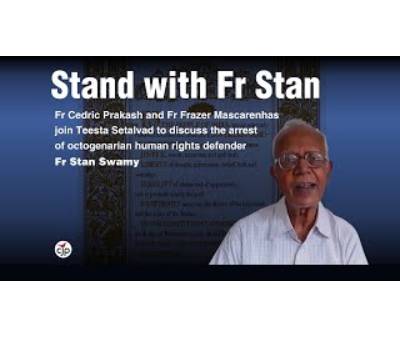 Bhima Koregaon incidence took place in 2019, 1st July. As thousands of dalits were returning after paying homage to dalits who lost their life in battle against Peshwa army in 1818, they were attacked. This battle had taken place between the Peshwa Baji Rao’s upper caste army against the East India Company’s army constituted mainly by Mahar community. Mahars saw it as a defeat of casteist forces and celebrated the victory, a victory pole was erected and annually dalits started visiting the place as a mark of defeat of Brahmanical forces. Babasaheb Ambedkar also visited the place in 1928. It became an ideological identity booster for the dalit community.
Bhima Koregaon incidence took place in 2019, 1st July. As thousands of dalits were returning after paying homage to dalits who lost their life in battle against Peshwa army in 1818, they were attacked. This battle had taken place between the Peshwa Baji Rao’s upper caste army against the East India Company’s army constituted mainly by Mahar community. Mahars saw it as a defeat of casteist forces and celebrated the victory, a victory pole was erected and annually dalits started visiting the place as a mark of defeat of Brahmanical forces. Babasaheb Ambedkar also visited the place in 1928. It became an ideological identity booster for the dalit community.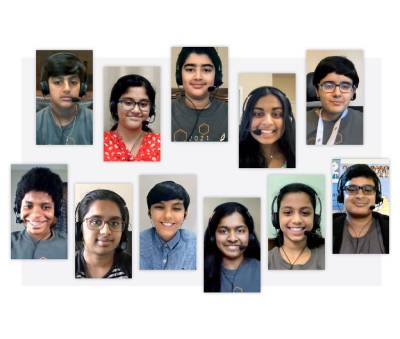 A spelling bee is a contest in which participants must spell aloud words announced by a judge. The high-profile Scripps National Spelling Bee is closely followed by students and their parents across the US and the finals are broadcast on prime-time television. This year, the winner got a cash prize of $50,000. Of the 11 finalists of the Scripps spelling bee held in the ESPN Sports Complex in Florida’s Orlando, Florida, nine were Indian-Americans. In the final round, Avant-garde was pitted against Chaitra Thummula from California, who dropped out after being unable to spell “neroli oil” correctly. Avant-garde scored her victory after spelling the word “Murraya”, a genus of tropical Australian trees.
A spelling bee is a contest in which participants must spell aloud words announced by a judge. The high-profile Scripps National Spelling Bee is closely followed by students and their parents across the US and the finals are broadcast on prime-time television. This year, the winner got a cash prize of $50,000. Of the 11 finalists of the Scripps spelling bee held in the ESPN Sports Complex in Florida’s Orlando, Florida, nine were Indian-Americans. In the final round, Avant-garde was pitted against Chaitra Thummula from California, who dropped out after being unable to spell “neroli oil” correctly. Avant-garde scored her victory after spelling the word “Murraya”, a genus of tropical Australian trees.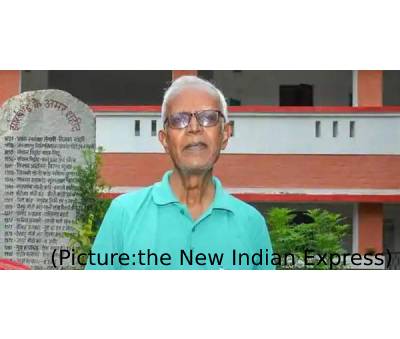 Pastor Wilson Jose, Pastor of the Grace International Church in Mineola, said while we have gathered here to celebrate Father Stan’s life, we would like to express our indignation as Pravasis, the way the political leaders and the judiciary treated him in India. Father Stan represented Christ’s teachings to its core and did his best to uplift the neglected ones by a caste system that is in place over centuries. Jesus said, love your enemies and pray for those who persecute you, and Fr. Stan’s life exemplified those principles. During the freedom struggle, Mahatma Gandhi was jailed many times by the British authorities. However, they respected his ideals and made sure no harm happened to him. Sadly today, the Government of India lacks even that basic level of humanity in the treatment of its own citizens!
Pastor Wilson Jose, Pastor of the Grace International Church in Mineola, said while we have gathered here to celebrate Father Stan’s life, we would like to express our indignation as Pravasis, the way the political leaders and the judiciary treated him in India. Father Stan represented Christ’s teachings to its core and did his best to uplift the neglected ones by a caste system that is in place over centuries. Jesus said, love your enemies and pray for those who persecute you, and Fr. Stan’s life exemplified those principles. During the freedom struggle, Mahatma Gandhi was jailed many times by the British authorities. However, they respected his ideals and made sure no harm happened to him. Sadly today, the Government of India lacks even that basic level of humanity in the treatment of its own citizens!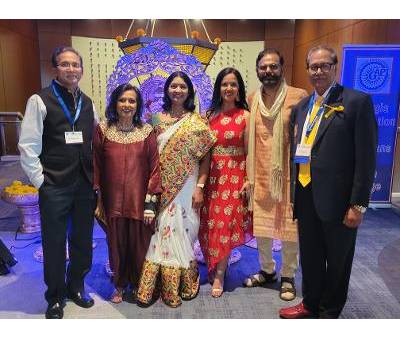 Dr. Jonnalagadda, who had assumed office a year ago during a virtual convention, told the AAPI delegates, “Despite the Covid pandemic and the many challenges AAPI had to face, “I am proud of the many accomplishments under my leadership. I am grateful for the immense and life changing moments, probably the best of my life ever, that came with my association with and leading AAPI.” Describing how his own life has changed over the past years, he said, “Working with many physicians motivated me to be a better physician myself. I understood the higher meaning of being a physician, especially even more now during the COVID pandemic. AAPI has given me so much — networking, advocacy, and education — and I am honored to serve this noble organization. I sincerely appreciate the trust you placed in me as the President of AAPI, and I am deeply committed to continue to work for you.”
Dr. Jonnalagadda, who had assumed office a year ago during a virtual convention, told the AAPI delegates, “Despite the Covid pandemic and the many challenges AAPI had to face, “I am proud of the many accomplishments under my leadership. I am grateful for the immense and life changing moments, probably the best of my life ever, that came with my association with and leading AAPI.” Describing how his own life has changed over the past years, he said, “Working with many physicians motivated me to be a better physician myself. I understood the higher meaning of being a physician, especially even more now during the COVID pandemic. AAPI has given me so much — networking, advocacy, and education — and I am honored to serve this noble organization. I sincerely appreciate the trust you placed in me as the President of AAPI, and I am deeply committed to continue to work for you.”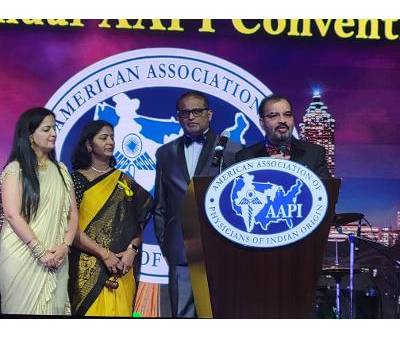 Dr. Jonnalagadda enumerated several programs under his leadership AAPI had undertaken in the past one year. “AAPI and the Charitable Foundation has several programs in India. Under my leadership with the pioneering efforts of Dr. SurenderPurohit, Chairman of AAPI CF, we have been able to strengthen the programs benefitting our motherland, India.” AAPI has been actively involved in community awareness programs like Obesity prevention, sharing medical knowledge at the weekly webinars on team building activities such as the Share a Blanket program, medical education programs such as CPR training, and educating the public and creating awareness on healthcare issues through ZeeTV and ITV Gold, NDTV, BBC, and CNN. Almost all the ethnic publications from coast to coast across the US and several leading publications in India have run timely stories on AAPI‘s several initiatives and programs.
Dr. Jonnalagadda enumerated several programs under his leadership AAPI had undertaken in the past one year. “AAPI and the Charitable Foundation has several programs in India. Under my leadership with the pioneering efforts of Dr. SurenderPurohit, Chairman of AAPI CF, we have been able to strengthen the programs benefitting our motherland, India.” AAPI has been actively involved in community awareness programs like Obesity prevention, sharing medical knowledge at the weekly webinars on team building activities such as the Share a Blanket program, medical education programs such as CPR training, and educating the public and creating awareness on healthcare issues through ZeeTV and ITV Gold, NDTV, BBC, and CNN. Almost all the ethnic publications from coast to coast across the US and several leading publications in India have run timely stories on AAPI‘s several initiatives and programs. AAPI has raised over $ 5 Million towards Covid relief funds for India and has purchased, shipped and coordinated with local authorities the supply and distribution of medical supplies to several parts of India. AAPI has shipped over a thousand Oxygen generators, masks, PPPs and essential supplies, and our pipeline will continue until the pandemic is overcome. As with anyone else, our doctors believe that they can best carry out our service to God through our service to our fellow humans.
AAPI has raised over $ 5 Million towards Covid relief funds for India and has purchased, shipped and coordinated with local authorities the supply and distribution of medical supplies to several parts of India. AAPI has shipped over a thousand Oxygen generators, masks, PPPs and essential supplies, and our pipeline will continue until the pandemic is overcome. As with anyone else, our doctors believe that they can best carry out our service to God through our service to our fellow humans.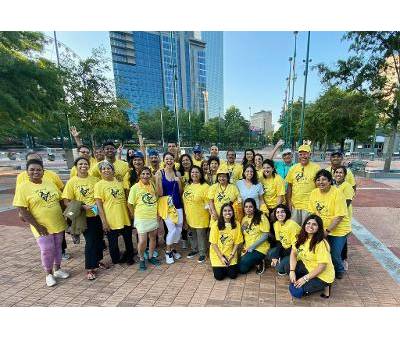 Delivering a spiritual discourse at the Convention, SadhviBhagawatiSaraswati, Author of “Hollywood to the Himalayas” led the AAPI delegates into an experience of peace and serenity. In her keynote address, Sadhviji inspired the participants to engage in the scholarly exchange of medical advances, to develop health policy agendas, and to encourage legislative priorities professionals in the field of medicine. She emphasized the important and critical connection between mind and body by saying “As the Bhagavad Gita reminds us: the mind is the cause of all problems and the mind is, therefore, the solution.” She offered them a “Mantra” which she called, CURED, where C stands for Connections – Connect with your inner self; U stands for Understand that you are a tool in the hands of God; R stands for Reconnect with your inner self day in and day out; E stands for Equanimity – stay balanced in all you do; and, D stands for “Dhanyavad or Devotion” that is being grateful which will lead one to enjoy happiness kin life.
Delivering a spiritual discourse at the Convention, SadhviBhagawatiSaraswati, Author of “Hollywood to the Himalayas” led the AAPI delegates into an experience of peace and serenity. In her keynote address, Sadhviji inspired the participants to engage in the scholarly exchange of medical advances, to develop health policy agendas, and to encourage legislative priorities professionals in the field of medicine. She emphasized the important and critical connection between mind and body by saying “As the Bhagavad Gita reminds us: the mind is the cause of all problems and the mind is, therefore, the solution.” She offered them a “Mantra” which she called, CURED, where C stands for Connections – Connect with your inner self; U stands for Understand that you are a tool in the hands of God; R stands for Reconnect with your inner self day in and day out; E stands for Equanimity – stay balanced in all you do; and, D stands for “Dhanyavad or Devotion” that is being grateful which will lead one to enjoy happiness kin life.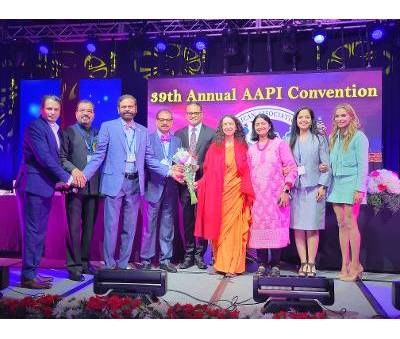 Dr. Sudhir Parikh, CEO of Parikh Media introduced the keynote speaker, AnandibenMafatbhai Patel, an Indian politician serving as the 28th and current Governor of Uttar Pradesh. She also served as Governor of Madhya Pradesh. She has served as the former Chief Minister of Gujarat. She was the first female chief minister of the state, he said. In her virtual address, she congratulated AAPI for organizing the convention and thanked them for their selfless services to India, the US and the humanity. Dr. Bobby Mukkamala, Chair of BOT at American Medical Association shared with nostalgia his long association with AAPI, growing up as a child and now, be leading the largest Medical Association in the US. Aaishwariya A Gulani, Valedictorian from The International Bolles School and a 3rd year Medical Student having held leadership roles from academia as recognized by the United Nations to community service globally as the reigning Miss India USA participated in the Fashion Show.
Dr. Sudhir Parikh, CEO of Parikh Media introduced the keynote speaker, AnandibenMafatbhai Patel, an Indian politician serving as the 28th and current Governor of Uttar Pradesh. She also served as Governor of Madhya Pradesh. She has served as the former Chief Minister of Gujarat. She was the first female chief minister of the state, he said. In her virtual address, she congratulated AAPI for organizing the convention and thanked them for their selfless services to India, the US and the humanity. Dr. Bobby Mukkamala, Chair of BOT at American Medical Association shared with nostalgia his long association with AAPI, growing up as a child and now, be leading the largest Medical Association in the US. Aaishwariya A Gulani, Valedictorian from The International Bolles School and a 3rd year Medical Student having held leadership roles from academia as recognized by the United Nations to community service globally as the reigning Miss India USA participated in the Fashion Show.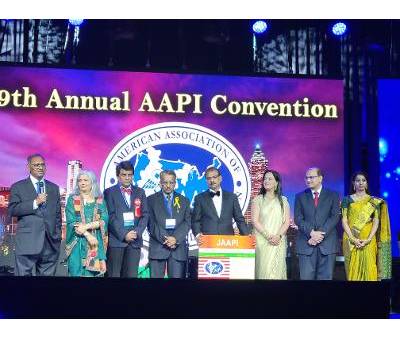 The concluding day of the convention had the usual pomp and show displayed in music and dance by the local organizing committee of the Convention headed by Dr. SreeniGangasani, who and his team were praised for their hardwork, dedication and creative ideas in putting together aan amazing convention in less than three months. “We are delighted to have been able to plan and organize the convention in record time,” said Dr. Gangasani. Calling it a historic convention, the Cardiologist from Atlanta said, “For the first time ever, we had to stop registration as we had reached the required number of participants for the convention, disappointing many who wanted to come and join the annual meet. Thank you for joining the AAPI community as we celebrate the victory of science over calamity while paying tribute to all the fallen healthcare workers including some from AAPI family. We also want to show the world that we can start socializing with precautions once you are vaccinated,” added Dr. Gangasani.
The concluding day of the convention had the usual pomp and show displayed in music and dance by the local organizing committee of the Convention headed by Dr. SreeniGangasani, who and his team were praised for their hardwork, dedication and creative ideas in putting together aan amazing convention in less than three months. “We are delighted to have been able to plan and organize the convention in record time,” said Dr. Gangasani. Calling it a historic convention, the Cardiologist from Atlanta said, “For the first time ever, we had to stop registration as we had reached the required number of participants for the convention, disappointing many who wanted to come and join the annual meet. Thank you for joining the AAPI community as we celebrate the victory of science over calamity while paying tribute to all the fallen healthcare workers including some from AAPI family. We also want to show the world that we can start socializing with precautions once you are vaccinated,” added Dr. Gangasani.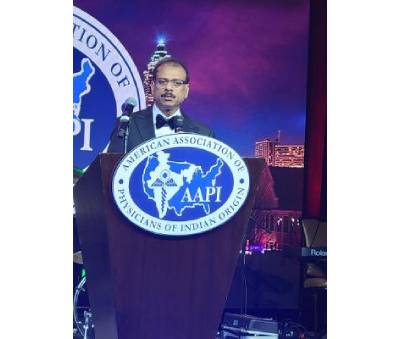 AAPI recognized the current Executive Committee Members, BOT members and several others who have worked hard to make the vision and mission of AAPI come alive. Prominent among them are: Dr. Radhu Agrawal was bestowed with AAPI Lifetime Achievement Award; AAPI Most Distinguished Physician Award was given to Dr. DhanireddyRamasubbareddy; AAPI Most Distinguished Service Award was given to Dr. Suresh Gupta; AAPI Most Distinguished YPS Award went to Dr. Purvi Parikh; and, AAPI Most Distinguished Community Service was bestowed on Dr. Sujatha Reddy. Dr. Raghu Lolabhattu, Convention Vice Chair shared with the delegates about how in a matter of less than three months the Atlanta Chapter has put together a fabulous convention. He later on called on stage every member of the convention committee, while Dr. Lonnalagadda and Dr. Gangasani recognized them with a plaque. The past Presidents of were called on state on the 2nd night’s gala and were recognized for their leadership and continued guidance.
AAPI recognized the current Executive Committee Members, BOT members and several others who have worked hard to make the vision and mission of AAPI come alive. Prominent among them are: Dr. Radhu Agrawal was bestowed with AAPI Lifetime Achievement Award; AAPI Most Distinguished Physician Award was given to Dr. DhanireddyRamasubbareddy; AAPI Most Distinguished Service Award was given to Dr. Suresh Gupta; AAPI Most Distinguished YPS Award went to Dr. Purvi Parikh; and, AAPI Most Distinguished Community Service was bestowed on Dr. Sujatha Reddy. Dr. Raghu Lolabhattu, Convention Vice Chair shared with the delegates about how in a matter of less than three months the Atlanta Chapter has put together a fabulous convention. He later on called on stage every member of the convention committee, while Dr. Lonnalagadda and Dr. Gangasani recognized them with a plaque. The past Presidents of were called on state on the 2nd night’s gala and were recognized for their leadership and continued guidance.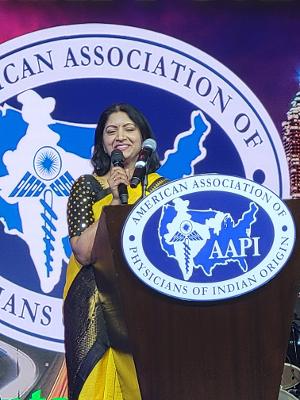 In her inaugural address after she was administered the oath of Office, Dr. Gotimukula reminded the AAPI members about our origin. “We came to the US pursuing the American Dream. Through hard work and a bit of luck, most of us achieved that dream and have become successful and caring doctors who play a crucial role in the American healthcare system. We serve patients. Raise money for local causes. Contribute to our education system and improve the lives of millions of Americans. We joined AAPI to socialize and meet others like us and in that journey learned that through this wonderful organization, we were able to make a bigger impact with the many academic, philanthropic and social initiatives.”
In her inaugural address after she was administered the oath of Office, Dr. Gotimukula reminded the AAPI members about our origin. “We came to the US pursuing the American Dream. Through hard work and a bit of luck, most of us achieved that dream and have become successful and caring doctors who play a crucial role in the American healthcare system. We serve patients. Raise money for local causes. Contribute to our education system and improve the lives of millions of Americans. We joined AAPI to socialize and meet others like us and in that journey learned that through this wonderful organization, we were able to make a bigger impact with the many academic, philanthropic and social initiatives.” A resident of San Antonio, TX, Dr.Gotimukula is a board certified Pediatric Anesthesiologist, practicing since 2007, is affiliated with Christus Santa Rosa, Baptist and Methodist Healthcare systems in San Antonio. After graduating with distinction from Kakatiya Medical College, NTR University of Health Sciences in India, she did Residency at University of Miami & University of Illinois, and Fellowship in Pediatric Anesthesiology at University of Michigan.
A resident of San Antonio, TX, Dr.Gotimukula is a board certified Pediatric Anesthesiologist, practicing since 2007, is affiliated with Christus Santa Rosa, Baptist and Methodist Healthcare systems in San Antonio. After graduating with distinction from Kakatiya Medical College, NTR University of Health Sciences in India, she did Residency at University of Miami & University of Illinois, and Fellowship in Pediatric Anesthesiology at University of Michigan.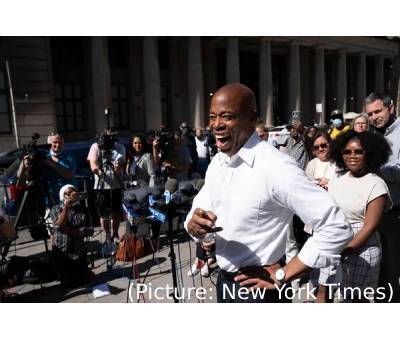 New York’s second Black mayor if he is elected in November’s general election over the Republican nominee, radio host Curtis Sliwa, because winning the primary in the heavily Democratic city is tantamount to winning the election. This was the city’s first major primary to use a ranked choice voting system meant to avoid costly runoffs and in which voters could order their top five choices, with their ballot moving to their next pick if their previous one was eliminated until one candidate claimed 50 percent support. Adams had led by nearly 15,000 first-choice votes after in-person voting concluded, and held on after about 125,000 thousand absentee ballots were counted and ranked choices tallied in an election run in the shadow of the pandemic that ravaged the city last year.
New York’s second Black mayor if he is elected in November’s general election over the Republican nominee, radio host Curtis Sliwa, because winning the primary in the heavily Democratic city is tantamount to winning the election. This was the city’s first major primary to use a ranked choice voting system meant to avoid costly runoffs and in which voters could order their top five choices, with their ballot moving to their next pick if their previous one was eliminated until one candidate claimed 50 percent support. Adams had led by nearly 15,000 first-choice votes after in-person voting concluded, and held on after about 125,000 thousand absentee ballots were counted and ranked choices tallied in an election run in the shadow of the pandemic that ravaged the city last year.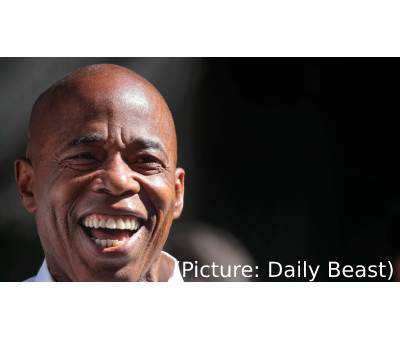 Police figures last month showed crime in the city rose by 22% in the past 12 months and shootings were up 73%. Adams, 60, is a moderate Democrat who denounced the “defund the police” movement during the campaign. On the stump, he sought to tread a fine line between promising to reform the New York Police Department (NYPD) and keeping New Yorkers safe from crime. Adams told supporters on the night of last month’s primary election: “If black lives really matter, it can’t only be against police abuse. It has to be against the violence that’s ripping apart our communities.”
Police figures last month showed crime in the city rose by 22% in the past 12 months and shootings were up 73%. Adams, 60, is a moderate Democrat who denounced the “defund the police” movement during the campaign. On the stump, he sought to tread a fine line between promising to reform the New York Police Department (NYPD) and keeping New Yorkers safe from crime. Adams told supporters on the night of last month’s primary election: “If black lives really matter, it can’t only be against police abuse. It has to be against the violence that’s ripping apart our communities.”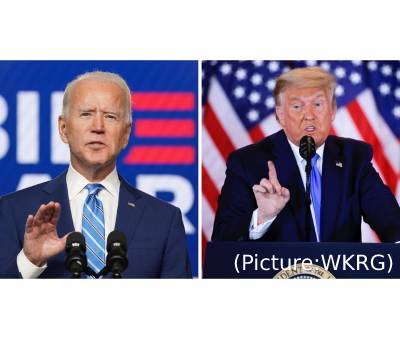 Five main factors account for Biden’s success.
Five main factors account for Biden’s success. Shri Shirdi Sai Mandir, Rolling Meadows kicked the month-long Shri Venkateswara and Navagraha Praana Prathistha Mahotsavam- July 2021 with the Jaladhivasam event on Sunday, July 4 th, 2021 During Jaladhivasam, the Vigrahas are completely immersed in water in a reclining position. This is done to emphasize centrality of water in the Vedas. Water is the essence of Jyothi or light. The essence of the mantras chanted during this ritual is that all entities including vital air, animals and food are a form of water. Water shines brilliantly by itself and cannot be ruled over by any other entity. Truth is also considered as a form of water. Devotees sang “Govinda, Govinda” accompanied by sounds of temple bells, conch and musical instruments during this event and poured water over Lord Venkateswara and Navagrahas to immerse them in water completely.
Shri Shirdi Sai Mandir, Rolling Meadows kicked the month-long Shri Venkateswara and Navagraha Praana Prathistha Mahotsavam- July 2021 with the Jaladhivasam event on Sunday, July 4 th, 2021 During Jaladhivasam, the Vigrahas are completely immersed in water in a reclining position. This is done to emphasize centrality of water in the Vedas. Water is the essence of Jyothi or light. The essence of the mantras chanted during this ritual is that all entities including vital air, animals and food are a form of water. Water shines brilliantly by itself and cannot be ruled over by any other entity. Truth is also considered as a form of water. Devotees sang “Govinda, Govinda” accompanied by sounds of temple bells, conch and musical instruments during this event and poured water over Lord Venkateswara and Navagrahas to immerse them in water completely. The event was organized by the founder and President of the International Ahimsa Foundation Dr. Neeta Jain. Due to her persistent hard work and networking, Dr. Jain has been elected as an Indian American female Democratic District Leader in New York, at present representingAssembly District 25 Part B in Queens. She is an accomplished educator and civic & community leader. Being a Jain, she is a passionate advocate for non-violence and peace. To promote these values, she founded and presides over the International Ahimsa Foundation, a domestic non-profit organization founded in 2012 to promote the study and practice of non-violence and peace in educational institutes.
The event was organized by the founder and President of the International Ahimsa Foundation Dr. Neeta Jain. Due to her persistent hard work and networking, Dr. Jain has been elected as an Indian American female Democratic District Leader in New York, at present representingAssembly District 25 Part B in Queens. She is an accomplished educator and civic & community leader. Being a Jain, she is a passionate advocate for non-violence and peace. To promote these values, she founded and presides over the International Ahimsa Foundation, a domestic non-profit organization founded in 2012 to promote the study and practice of non-violence and peace in educational institutes.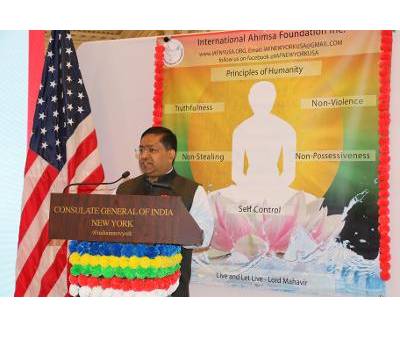 The Honorable Bishnu Prasad Gautam, Consul General of Nepal, NY, who spoke from the heart about the positive relationship and similar values between the Nepali and Indian diasporas and the importance of non-violence, peace, and unity. Sister Sabitha Geer, representative of the Brahma Kumaris to the United Nations, who spoke about the connection between awareness, attitude, vision, action, and the world, and guided the audience through some mindful meditation. Community leader Ashok Sancheti, who emphasized the importance of sharing and spreading happiness for prosperity and community success. NYC Mayor Bill de Blasio ofFice was represented by Mr. Rohan Narain, who read his letter to the audience and Queens borough President Donavon Richards office was represented by Mr. Brent Weitzberg.
The Honorable Bishnu Prasad Gautam, Consul General of Nepal, NY, who spoke from the heart about the positive relationship and similar values between the Nepali and Indian diasporas and the importance of non-violence, peace, and unity. Sister Sabitha Geer, representative of the Brahma Kumaris to the United Nations, who spoke about the connection between awareness, attitude, vision, action, and the world, and guided the audience through some mindful meditation. Community leader Ashok Sancheti, who emphasized the importance of sharing and spreading happiness for prosperity and community success. NYC Mayor Bill de Blasio ofFice was represented by Mr. Rohan Narain, who read his letter to the audience and Queens borough President Donavon Richards office was represented by Mr. Brent Weitzberg.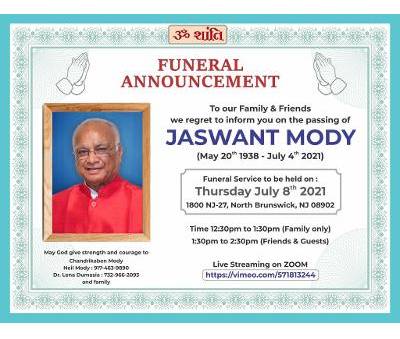 Jaswant was born in Mumbai, India on May 20, 1938. After attending the University of Bombay, he followed his dream to come to the United States of America for freedom and opportunity. Jaswant worked and saved for the fare, and after 1 months of traveling by passenger ship, he arrived in New York. He then began his American Dream. Jaswant attended universities in Utah, Ohio, and New Jersey. Jaswant married and settled down in New Jersey and worked as an engineer for over 5 decades. He retired in 2012 from the DEP of NYC after working there for over 25 years.
Jaswant was born in Mumbai, India on May 20, 1938. After attending the University of Bombay, he followed his dream to come to the United States of America for freedom and opportunity. Jaswant worked and saved for the fare, and after 1 months of traveling by passenger ship, he arrived in New York. He then began his American Dream. Jaswant attended universities in Utah, Ohio, and New Jersey. Jaswant married and settled down in New Jersey and worked as an engineer for over 5 decades. He retired in 2012 from the DEP of NYC after working there for over 25 years.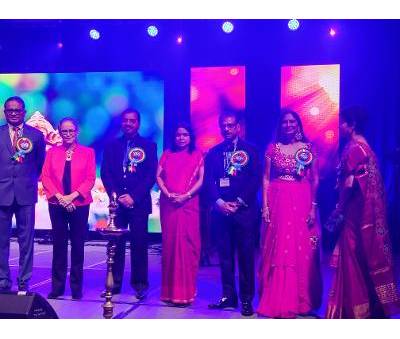
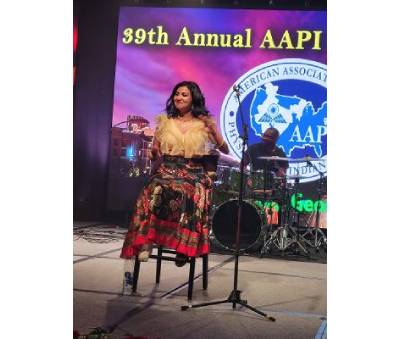 Dr. Smitha Lodha, widow of Dr. Ajay Lodha addressed the AAPI members, thanking them for their support as the late President of AAPI suffered Covid related complications and succumbed to the deadly virus. She praised AAPI and the medical fraternity for their courage and selfless service to bring health and well being to millions across the US and around the world.
Dr. Smitha Lodha, widow of Dr. Ajay Lodha addressed the AAPI members, thanking them for their support as the late President of AAPI suffered Covid related complications and succumbed to the deadly virus. She praised AAPI and the medical fraternity for their courage and selfless service to bring health and well being to millions across the US and around the world.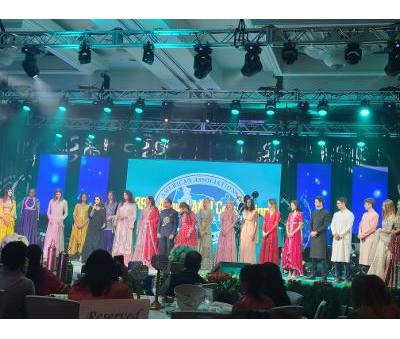 After inaugurating the Convention with traditional prayers and blessings by Hindu Priests, Congressman Buddy Carter, representing the 1st District in Georgia, said, “If there is anything that the COVID-19 pandemic laid bare it is that our country is too dependent on foreign sources of critical pharmaceutical and medical supplies. I reintroduced bipartisan, bicameral legislation to retake control of America’s health care supply chain. For America’s national security, the legislation incentivizes the domestic manufacturing of drugs and other medical supplies to make the U.S. supply chain less dependent on foreign countries like China.” The only pharmacist in the US Congress, Rep. Carter referred to how the middlemen hike up the prize of drugs by upto 47% in the US, and urged the AAPI fraternity to advocate for more patient-centered care.
After inaugurating the Convention with traditional prayers and blessings by Hindu Priests, Congressman Buddy Carter, representing the 1st District in Georgia, said, “If there is anything that the COVID-19 pandemic laid bare it is that our country is too dependent on foreign sources of critical pharmaceutical and medical supplies. I reintroduced bipartisan, bicameral legislation to retake control of America’s health care supply chain. For America’s national security, the legislation incentivizes the domestic manufacturing of drugs and other medical supplies to make the U.S. supply chain less dependent on foreign countries like China.” The only pharmacist in the US Congress, Rep. Carter referred to how the middlemen hike up the prize of drugs by upto 47% in the US, and urged the AAPI fraternity to advocate for more patient-centered care.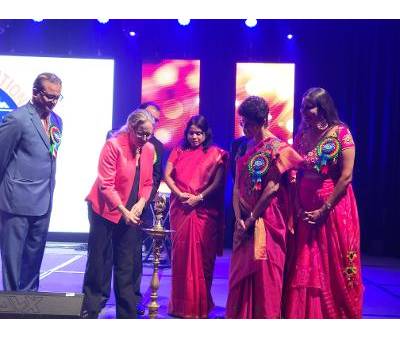 Dr. Kulkarni spoke about the many programs and plans offered by the Government of India to alleviate the sufferings of the people of India during the pandemic. Dr. Kulkarni stressed the importance of Indo-US Strategic Alliance, especially in the health sector, while pointing out India’s contributions providing the world with quality drugs for cheaper prizes.
Dr. Kulkarni spoke about the many programs and plans offered by the Government of India to alleviate the sufferings of the people of India during the pandemic. Dr. Kulkarni stressed the importance of Indo-US Strategic Alliance, especially in the health sector, while pointing out India’s contributions providing the world with quality drugs for cheaper prizes.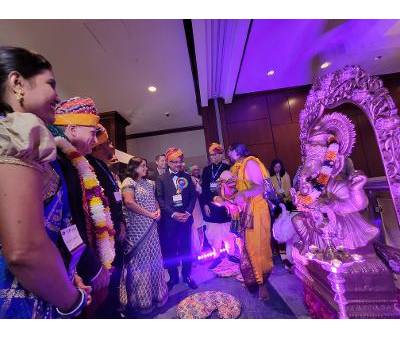
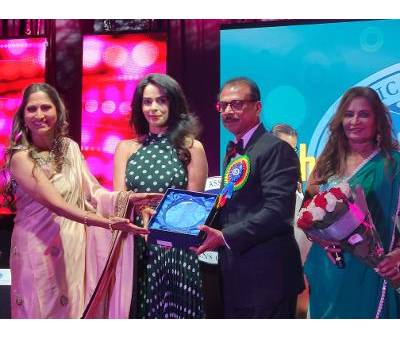 The Women’s Forum led by Drs. Anjana Samadhar, Uma Jonnalagadda, and Udaya Shivangi featured eminent women leaders, including Keisha Lance Bottoms, Mayor of Atlanta, Dr. Swati Kulkarni, India’s Consular General in Atlanta, Prof. Amita Sehgal, Professor of Neuroscience at UPENN, Dr. Nahid Bhadella, Director of Center for Emerging Infectious Diseases Policy & Reasearch; and, Dr. Mona Khanna, Emmy Award Winning Journalist.
The Women’s Forum led by Drs. Anjana Samadhar, Uma Jonnalagadda, and Udaya Shivangi featured eminent women leaders, including Keisha Lance Bottoms, Mayor of Atlanta, Dr. Swati Kulkarni, India’s Consular General in Atlanta, Prof. Amita Sehgal, Professor of Neuroscience at UPENN, Dr. Nahid Bhadella, Director of Center for Emerging Infectious Diseases Policy & Reasearch; and, Dr. Mona Khanna, Emmy Award Winning Journalist.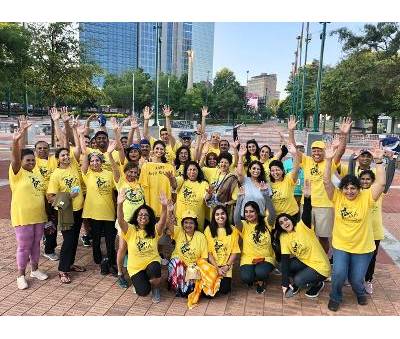 Her advice for younger generation if they want to follow her, Sherawat said, “If you want to be an actress, I would say, start with your dance training and relaxing training.”
Her advice for younger generation if they want to follow her, Sherawat said, “If you want to be an actress, I would say, start with your dance training and relaxing training.”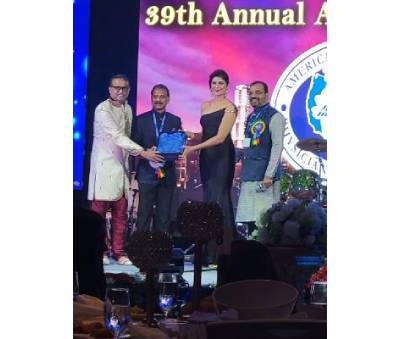 During the nearly 2 hours long live performance. She showcased the influences of her Indian-American heritage to create music that is refreshingly unique and contemporary, seamlessly fusing together the intricacies of Indian music with elements of electronic and hip-hop for an undeniably catchy sound.
During the nearly 2 hours long live performance. She showcased the influences of her Indian-American heritage to create music that is refreshingly unique and contemporary, seamlessly fusing together the intricacies of Indian music with elements of electronic and hip-hop for an undeniably catchy sound.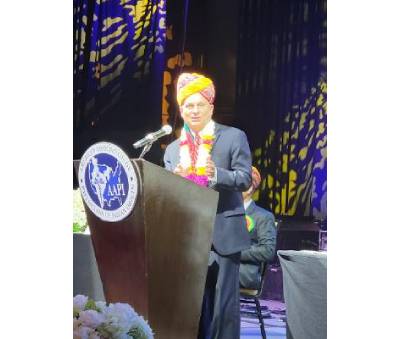 Known to be a leading ethnic medical organization that represents nearly 100,000 physicians and fellows of Indian Origin in the US, and being their voice and providing a forum to its members to collectively work together to meet their diverse needs, AAPI members are proud to contribute to the wellbeing of their motherland India and their adopted land, the United States. The convention is forum to network, share knowledge and thoughts, and thus, enrich one another, and rededicate ourselves for the health and wellbeing of all peoples of the world. For more details, please visit:
Known to be a leading ethnic medical organization that represents nearly 100,000 physicians and fellows of Indian Origin in the US, and being their voice and providing a forum to its members to collectively work together to meet their diverse needs, AAPI members are proud to contribute to the wellbeing of their motherland India and their adopted land, the United States. The convention is forum to network, share knowledge and thoughts, and thus, enrich one another, and rededicate ourselves for the health and wellbeing of all peoples of the world. For more details, please visit: 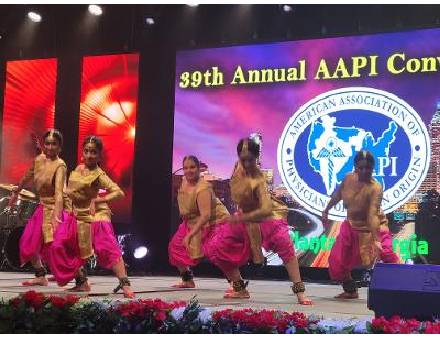 “Remembering and memorializing the brave AAPI Warriors and thousands of healthcare workers, who have sacrificed their lives at the service of humanity, especially during the Deadly Covid Pandemic is the major theme during the Convention,” said Dr. Sudhakar Jonnalagadda, President of AAPI. “This convention is a tribute to those who have lost their lives and to the frontline medical professionals who are at the forefront, combating the pandemic around the globe,” he added.
“Remembering and memorializing the brave AAPI Warriors and thousands of healthcare workers, who have sacrificed their lives at the service of humanity, especially during the Deadly Covid Pandemic is the major theme during the Convention,” said Dr. Sudhakar Jonnalagadda, President of AAPI. “This convention is a tribute to those who have lost their lives and to the frontline medical professionals who are at the forefront, combating the pandemic around the globe,” he added.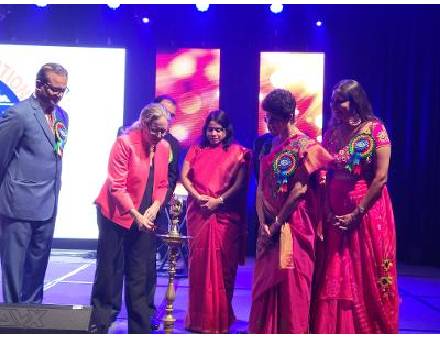 The annual convention this year is being organized by AAPI’s Atlanta Chapter, chaired by Dr. Sreeni Gangasani. The inaugural Nite’s Gala was hosted by Georgia Association of Physicians of Indian Origin (GAPI), during which several leaders of GAPI, including Drs. Indrani Indrakrishnan, Raghu Lolabhattu, Manoj Shah, Yogesh Joshi, Arvind Gupta, PB Rao, Dilip Patel, Uma Jonnagalada and Tarun Gosh addressed the audience. In her address, Dr. Indrani Indrakrishnan shared with the audience of GAPI’s educational, philanthropic, humanitarian, political, entertaining and social activities. Educational scholarships were presented to deserving students from the region.
The annual convention this year is being organized by AAPI’s Atlanta Chapter, chaired by Dr. Sreeni Gangasani. The inaugural Nite’s Gala was hosted by Georgia Association of Physicians of Indian Origin (GAPI), during which several leaders of GAPI, including Drs. Indrani Indrakrishnan, Raghu Lolabhattu, Manoj Shah, Yogesh Joshi, Arvind Gupta, PB Rao, Dilip Patel, Uma Jonnagalada and Tarun Gosh addressed the audience. In her address, Dr. Indrani Indrakrishnan shared with the audience of GAPI’s educational, philanthropic, humanitarian, political, entertaining and social activities. Educational scholarships were presented to deserving students from the region.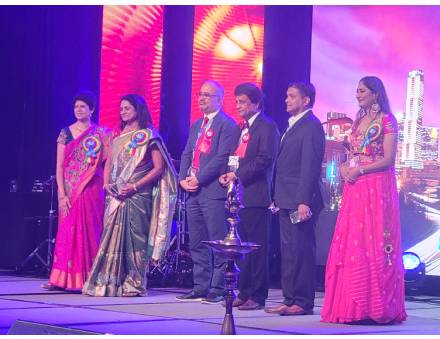 Dr. Kulkarni shared with the audience about the many programs and plans offered by the Government of India to alleviate the sufferings of the people of India during the pandemic. Dr. Kulkarni stressed the importance of Indo-US Strategic Alliance, especially in the health sector, while pointing out India’s contributions providing the world with quality drugs for cheaper prizes. Congresswoman Carolyn Bourdeaux representing the 7th Congressional district of Georgia was introduced to the audience by Dr. Sreeni Gangasani. Sharing her own close association with the South Asian community, Rep. Carolyn Bourdeaux said, her district is home to the largest South Asian population in the South East. “I have so many wonderful friends in this community for many years I have had many friends who are from South Asia,” she said. “I have been in Washington for about 6 months and I have worked very hard to Advocate on behalf of the South Asian Community.”
Dr. Kulkarni shared with the audience about the many programs and plans offered by the Government of India to alleviate the sufferings of the people of India during the pandemic. Dr. Kulkarni stressed the importance of Indo-US Strategic Alliance, especially in the health sector, while pointing out India’s contributions providing the world with quality drugs for cheaper prizes. Congresswoman Carolyn Bourdeaux representing the 7th Congressional district of Georgia was introduced to the audience by Dr. Sreeni Gangasani. Sharing her own close association with the South Asian community, Rep. Carolyn Bourdeaux said, her district is home to the largest South Asian population in the South East. “I have so many wonderful friends in this community for many years I have had many friends who are from South Asia,” she said. “I have been in Washington for about 6 months and I have worked very hard to Advocate on behalf of the South Asian Community.”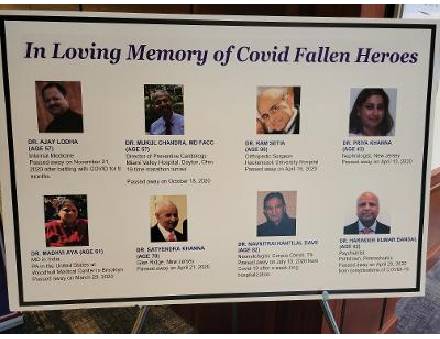 Describing herself as a friend of India and Indian Americans, the Congresswoman said, she is an active member of the India Caucus in the House, she said, “India is a very very important strategic partner to the United States,” and promised to work with the federal government in helping India especially during the pandemic. The inaugural nite’s star attraction was the young and energetic artist Vidya Vox who entertained the audience with song, music and dances. During the nearly 2 hours long live performance. She showcased the influences of her Indian-American heritage to create music that is refreshingly unique and contemporary, seamlessly fusing together the intricacies of Indian music with elements of electronic and hip-hop for an undeniably catchy sound. The delegates were presented with live performances of Bhartanatyam, Thillana and fusion dances by local artists, displaying unique talents in Indian classical dance forms. The popular and much loved Mehfil E Khaas provided AAPI members and families a platform to showcase their talents impromptu, in music, dance, jokes and Shero Shayari in an informal setting.
Describing herself as a friend of India and Indian Americans, the Congresswoman said, she is an active member of the India Caucus in the House, she said, “India is a very very important strategic partner to the United States,” and promised to work with the federal government in helping India especially during the pandemic. The inaugural nite’s star attraction was the young and energetic artist Vidya Vox who entertained the audience with song, music and dances. During the nearly 2 hours long live performance. She showcased the influences of her Indian-American heritage to create music that is refreshingly unique and contemporary, seamlessly fusing together the intricacies of Indian music with elements of electronic and hip-hop for an undeniably catchy sound. The delegates were presented with live performances of Bhartanatyam, Thillana and fusion dances by local artists, displaying unique talents in Indian classical dance forms. The popular and much loved Mehfil E Khaas provided AAPI members and families a platform to showcase their talents impromptu, in music, dance, jokes and Shero Shayari in an informal setting.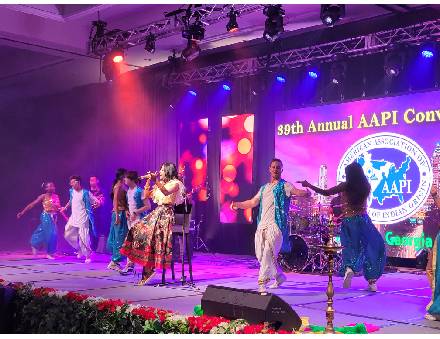 Physicians of Indian Origin in the United States are reputed to be leading health care providers, holding crucial positions in various hospitals and health care facilities around the nation and the world. Known to be a leading ethnic medical organization that represents nearly 100,000 physicians and fellows of Indian Origin in the US, and being their voice and providing a forum to its members to collectively work together to meet their diverse needs, AAPI members are proud to contribute to the wellbeing of their motherland India and their adopted land, the United States. The convention is forum to network, share knowledge and thoughts, and thus, enrich one another, and rededicate ourselves for the health and wellbeing of all peoples of the world.
Physicians of Indian Origin in the United States are reputed to be leading health care providers, holding crucial positions in various hospitals and health care facilities around the nation and the world. Known to be a leading ethnic medical organization that represents nearly 100,000 physicians and fellows of Indian Origin in the US, and being their voice and providing a forum to its members to collectively work together to meet their diverse needs, AAPI members are proud to contribute to the wellbeing of their motherland India and their adopted land, the United States. The convention is forum to network, share knowledge and thoughts, and thus, enrich one another, and rededicate ourselves for the health and wellbeing of all peoples of the world.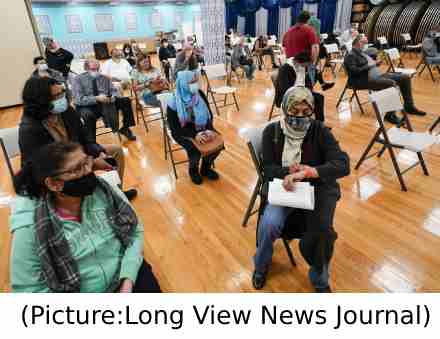 Dr. Turner says the research team followed 41 people who received an mRNA vaccine over the course of six months. Of those, 14 participants provided periodic samples of their lymph nodes in order to measure the immune reaction set in to motion by the vaccine. What they found caught them a bit off guard.
Dr. Turner says the research team followed 41 people who received an mRNA vaccine over the course of six months. Of those, 14 participants provided periodic samples of their lymph nodes in order to measure the immune reaction set in to motion by the vaccine. What they found caught them a bit off guard. And even after lymph node activity returns to normal, Dr. Turner says those specially trained cells are likely to remain for years. “We know that these cells can migrate to the bone marrow and persist for decades, generating antibodies,” he said. Dr. Turner says there is still a chance that booster shots could be needed if a variant escapes our immune response.
And even after lymph node activity returns to normal, Dr. Turner says those specially trained cells are likely to remain for years. “We know that these cells can migrate to the bone marrow and persist for decades, generating antibodies,” he said. Dr. Turner says there is still a chance that booster shots could be needed if a variant escapes our immune response.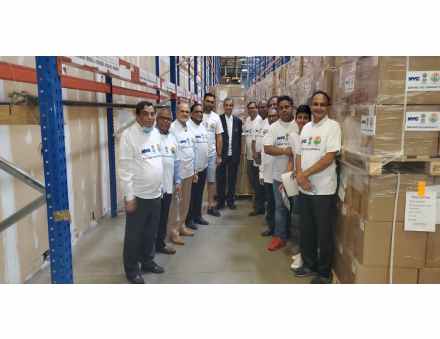 Besides the executive and board members of FIA, in attendance was Deputy Consul General of New York Shatrughna Sinha who took inventory of the shipment. He praised the efforts of FIA in taking charge of the cargo and handling the logistics for its timely shipment and thanked the City of New York, Maersk Air India and all the sponsors for their contributions. Parveen Bansal, general secretary and executive committee member of FIA Tristate who was appointed to lead the logistical efforts, said, “It is a privilege to be part of such an unprecedented relief effort and to serve our motherland”. Prabir Roy, the senior-most FIA board member in attendance, said, “The successful engagement of FIA in seeing this medical cargo through has turned the page in its history and made a statement with its work in service of the motherland.”
Besides the executive and board members of FIA, in attendance was Deputy Consul General of New York Shatrughna Sinha who took inventory of the shipment. He praised the efforts of FIA in taking charge of the cargo and handling the logistics for its timely shipment and thanked the City of New York, Maersk Air India and all the sponsors for their contributions. Parveen Bansal, general secretary and executive committee member of FIA Tristate who was appointed to lead the logistical efforts, said, “It is a privilege to be part of such an unprecedented relief effort and to serve our motherland”. Prabir Roy, the senior-most FIA board member in attendance, said, “The successful engagement of FIA in seeing this medical cargo through has turned the page in its history and made a statement with its work in service of the motherland.”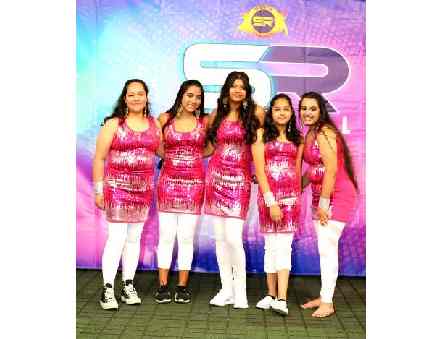 S R Dance Academy was first launched on April 28th, 2020 and is a dance school open to all ages and skill levels ranging from beginner to advanced. The main objective of S R Dance Academy is to connect our community with our rich cultural heritage and provide a platform for kids and adults to learn Bollywood Dance and Bolly Zumba from the best Bollywood Choreographer and dance teacher. They have partnered with two incredibly talented Choreographers Elizar Rodriguez and Shirley Rodriguez who have extensive experience working in Bollywood for the past 20 years. They have worked with iconic superstars such as Salman Khan, Varun Dhavan, Priyanka Chopra, Katrina Kaif, and many more, and have performed at prestigious events, such as The IIFA Awards. Not only are they talented dancers, but also have a love for teaching dance.
S R Dance Academy was first launched on April 28th, 2020 and is a dance school open to all ages and skill levels ranging from beginner to advanced. The main objective of S R Dance Academy is to connect our community with our rich cultural heritage and provide a platform for kids and adults to learn Bollywood Dance and Bolly Zumba from the best Bollywood Choreographer and dance teacher. They have partnered with two incredibly talented Choreographers Elizar Rodriguez and Shirley Rodriguez who have extensive experience working in Bollywood for the past 20 years. They have worked with iconic superstars such as Salman Khan, Varun Dhavan, Priyanka Chopra, Katrina Kaif, and many more, and have performed at prestigious events, such as The IIFA Awards. Not only are they talented dancers, but also have a love for teaching dance.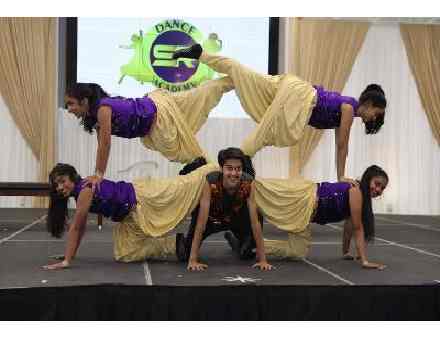 The In-Person Recital started with our Junior Troupe Team offering their Prayers to Lord Shree Ganesha. It is common in Indian tradition to start an event or a new beginning with a Prayer Song to invoke the blessings of God. Their youngest 4-7 years age category kids showcased their talents with a Bollywood Act on Baby Ko Cake Pasand Hai song which was a treat to the eyes with their charming dance movements. Bolly-Hop by 12-21 years group showcased a vivacious act through The Jawani Song. Dangal Song was performed by 8-11 years group kids which has a great message conveyed through the song – ‘Whenever fate gives you a chance to do something and prove yourself, work at it and you’ll reap the reward’ and Adult Filmy Act had the parents dancing their heart-outs for a mix of Bollywood Songs. Adults proved that age is just a number when it came to dancing their hearts out. The Bolly-Hop & Semi-Classical act was performed in the 12-21 years category. Act 13 had our own Choreographers showing their prowess as to why they are the best in the town.
The In-Person Recital started with our Junior Troupe Team offering their Prayers to Lord Shree Ganesha. It is common in Indian tradition to start an event or a new beginning with a Prayer Song to invoke the blessings of God. Their youngest 4-7 years age category kids showcased their talents with a Bollywood Act on Baby Ko Cake Pasand Hai song which was a treat to the eyes with their charming dance movements. Bolly-Hop by 12-21 years group showcased a vivacious act through The Jawani Song. Dangal Song was performed by 8-11 years group kids which has a great message conveyed through the song – ‘Whenever fate gives you a chance to do something and prove yourself, work at it and you’ll reap the reward’ and Adult Filmy Act had the parents dancing their heart-outs for a mix of Bollywood Songs. Adults proved that age is just a number when it came to dancing their hearts out. The Bolly-Hop & Semi-Classical act was performed in the 12-21 years category. Act 13 had our own Choreographers showing their prowess as to why they are the best in the town. The new vaccination policy, which took considerable prodding and criticism from the Supreme Court before the Centre decided to act, will see the government purchasing 75% of the vaccines produced by the manufacturers and distributing it free to states, based on their population, disease burden and vaccination progress, with the remaining 25% production allocated for private hospitals. However, experts say that India needs to administer a minimum of 1 crore doses a day in order to inoculate its 95-crore strong adult population by December. Moreover, vaccine availability is still patchy. That also explains why over 82% of the doses administered are the first shot.India’s vaccination record has been middling among the world’s 30 most populous countries with a rank 16 among them in terms of doses per 100 population. At 19.6 as of June 19, India’s level is less than a fifth of what the UK has achieved.
The new vaccination policy, which took considerable prodding and criticism from the Supreme Court before the Centre decided to act, will see the government purchasing 75% of the vaccines produced by the manufacturers and distributing it free to states, based on their population, disease burden and vaccination progress, with the remaining 25% production allocated for private hospitals. However, experts say that India needs to administer a minimum of 1 crore doses a day in order to inoculate its 95-crore strong adult population by December. Moreover, vaccine availability is still patchy. That also explains why over 82% of the doses administered are the first shot.India’s vaccination record has been middling among the world’s 30 most populous countries with a rank 16 among them in terms of doses per 100 population. At 19.6 as of June 19, India’s level is less than a fifth of what the UK has achieved. You normally must have earned income to claim the child tax credit. For this year, you’re entitled to the credit even if you were not employed and had no earned income. And whereas the usual $2,000 credit is only refundable up to $1,2000, the entire expanded credit is refundable. What “fully refundable” means is that if your total federal income tax liability is less than the credit amount, you receive the difference back as a refund. For example, if your total tax liability is $0 and your credit is $3,600, you’ll receive $3,600 back. If your tax liability is $2,000 and your credit is $3,000, you’ll receive $1,000 back. The income threshold to receive the full credit is $75,000 for a single filer.
You normally must have earned income to claim the child tax credit. For this year, you’re entitled to the credit even if you were not employed and had no earned income. And whereas the usual $2,000 credit is only refundable up to $1,2000, the entire expanded credit is refundable. What “fully refundable” means is that if your total federal income tax liability is less than the credit amount, you receive the difference back as a refund. For example, if your total tax liability is $0 and your credit is $3,600, you’ll receive $3,600 back. If your tax liability is $2,000 and your credit is $3,000, you’ll receive $1,000 back. The income threshold to receive the full credit is $75,000 for a single filer. Ambassador Randhir Kumar Jaiswal, the Chief Guest, commented “Yoga is a way of life. The idea of Yoga is truly universal and it must be heard, celebrated and promoted in each and every part of our society and community. The key is to not just celebrate Yoga as a health practice, for it needs to be celebrated in its entirety,” asserted Jaiswal. He highlighted how the International Yoga Day has evolved into in major annual event that’s celebrated across the globe ever since Prime Minister Narendra Modi proposed the idea during his speech at the United Nations General Assembly back in September 2014.
Ambassador Randhir Kumar Jaiswal, the Chief Guest, commented “Yoga is a way of life. The idea of Yoga is truly universal and it must be heard, celebrated and promoted in each and every part of our society and community. The key is to not just celebrate Yoga as a health practice, for it needs to be celebrated in its entirety,” asserted Jaiswal. He highlighted how the International Yoga Day has evolved into in major annual event that’s celebrated across the globe ever since Prime Minister Narendra Modi proposed the idea during his speech at the United Nations General Assembly back in September 2014. The event was inaugurated by all attendees by chanting “Om” and Acharya Performing Arts Academy students performed the “NrithyaYogasana” which is “Dance Yoga” invented by artistic director guru Asha Adiga Acharya by combining yoga and Indian classical dance moves together, to benefit the Pada (Feet), Anga (Body) and Mudra(Fingers). “NupuraGeetha” dance ensemble team started the performance with beautiful Ganesha dance, pure Alaripu, Mallari dance, expression filled dance based on Vachana, Anathapurageethe dance and ended the program with Charishnu dance which was choreographed creatively with yoga poses.
The event was inaugurated by all attendees by chanting “Om” and Acharya Performing Arts Academy students performed the “NrithyaYogasana” which is “Dance Yoga” invented by artistic director guru Asha Adiga Acharya by combining yoga and Indian classical dance moves together, to benefit the Pada (Feet), Anga (Body) and Mudra(Fingers). “NupuraGeetha” dance ensemble team started the performance with beautiful Ganesha dance, pure Alaripu, Mallari dance, expression filled dance based on Vachana, Anathapurageethe dance and ended the program with Charishnu dance which was choreographed creatively with yoga poses. Consul General of India NY Randhir Jaiswal, who briefly attended the event with DCG NY Shatrughan Sinha, appreciated and encouraged the participants.Celebrity yoga instructor, Reiki healer, and health coach Thara Natalie gave yoga lessons for all ages. She also shared health tips during the one-hour session. Singer and song writer Jay Sean was the guest of honor while former Miss America and American public speaker and actress Nina Davuluri, also a yoga practitioner, compered the event.
Consul General of India NY Randhir Jaiswal, who briefly attended the event with DCG NY Shatrughan Sinha, appreciated and encouraged the participants.Celebrity yoga instructor, Reiki healer, and health coach Thara Natalie gave yoga lessons for all ages. She also shared health tips during the one-hour session. Singer and song writer Jay Sean was the guest of honor while former Miss America and American public speaker and actress Nina Davuluri, also a yoga practitioner, compered the event. “Last year was tough for everyone. Now, the community is slowly reeling out of the pandemic. The benefits of yoga are known to the entire world. We hope this event can give a positive push to our attempts to get back to the pre-pandemic days,” said FIA chairman Ankur Vaidya. He expressed his gratitude to CGI NY Jaiswal and DCG Sinha for their continued support in making the Yoga Day celebration a success.FIA provided complimentary coffee, munchkins, water, T-shirt, and yoga mat to all participants in attendance and held an attendee raffle in which 5 Google home devices were raffled as thank-you giveaways to the attendees.
“Last year was tough for everyone. Now, the community is slowly reeling out of the pandemic. The benefits of yoga are known to the entire world. We hope this event can give a positive push to our attempts to get back to the pre-pandemic days,” said FIA chairman Ankur Vaidya. He expressed his gratitude to CGI NY Jaiswal and DCG Sinha for their continued support in making the Yoga Day celebration a success.FIA provided complimentary coffee, munchkins, water, T-shirt, and yoga mat to all participants in attendance and held an attendee raffle in which 5 Google home devices were raffled as thank-you giveaways to the attendees. Asked what he thought about civil rights in India under the current administration there, he told the media, “Democracy cannot just be a word; democracy is about who you care for, your people and education. We are human beings … in jeopardy. I think in India the government is stable but people are poor – too poor… We need to make it right,” Jackson said. Sounding hopeful about working with the Narendra Modi government, he said, “I think the moment we talk [with Modi], we can act together on economic policy and democracy. Modi and I should work together on democracy,” Jackson said. He asked the Indian diaspora to support the poor in India with no homes, work or jobs, saying, “We members of the diaspora are blessed to be in good shape.”
Asked what he thought about civil rights in India under the current administration there, he told the media, “Democracy cannot just be a word; democracy is about who you care for, your people and education. We are human beings … in jeopardy. I think in India the government is stable but people are poor – too poor… We need to make it right,” Jackson said. Sounding hopeful about working with the Narendra Modi government, he said, “I think the moment we talk [with Modi], we can act together on economic policy and democracy. Modi and I should work together on democracy,” Jackson said. He asked the Indian diaspora to support the poor in India with no homes, work or jobs, saying, “We members of the diaspora are blessed to be in good shape.”
 “In the age group of 1-10 years, 3.28 per cent of children contracted COVID-19 infection in the first wave while 3.05 per cent during the second wave. 8.03 per cent were infected in 11-20 years of age group in the first wave and 8.5 per cent in the second wave, ” said Agarwal. He added that prioritising vaccination should be the focus in the country and added that Covid-19 safe behavior should be followed despite low Covid-19 numbers to contain the virulent variants of Coronavirus.
“In the age group of 1-10 years, 3.28 per cent of children contracted COVID-19 infection in the first wave while 3.05 per cent during the second wave. 8.03 per cent were infected in 11-20 years of age group in the first wave and 8.5 per cent in the second wave, ” said Agarwal. He added that prioritising vaccination should be the focus in the country and added that Covid-19 safe behavior should be followed despite low Covid-19 numbers to contain the virulent variants of Coronavirus. Samip Joshi won the Democratic party Primary in his run for the Mayor of Edison Township. Joshi had many high-profile endorsements party high-ups favored him with, from U.S. Sen. Cory Booker, and Gov. Phil Murphy downwards, and was engaged in a battle with fellow Democrat Mahesh Bhagia. Joshi won 5,995 votes to Bhagia’s 3,185, according to centraljersey.com reporting based on Middlesex County Board of Elections.
Samip Joshi won the Democratic party Primary in his run for the Mayor of Edison Township. Joshi had many high-profile endorsements party high-ups favored him with, from U.S. Sen. Cory Booker, and Gov. Phil Murphy downwards, and was engaged in a battle with fellow Democrat Mahesh Bhagia. Joshi won 5,995 votes to Bhagia’s 3,185, according to centraljersey.com reporting based on Middlesex County Board of Elections. “This District is a purple district till a few years ago when it was all Republican,” she said. “I am very confident of winning the seat,” and she attributes that to the hard work done during the pandemic to keep the public informed and working as a team to marshal local and state resources and help small business and others. At the local grassroots level, Jaffer developed a Crisis Plan, and networked with very diverse communities. Jaffer’s ancestry goes back to the Kutch region of India and to Pakistan.
“This District is a purple district till a few years ago when it was all Republican,” she said. “I am very confident of winning the seat,” and she attributes that to the hard work done during the pandemic to keep the public informed and working as a team to marshal local and state resources and help small business and others. At the local grassroots level, Jaffer developed a Crisis Plan, and networked with very diverse communities. Jaffer’s ancestry goes back to the Kutch region of India and to Pakistan. Hirsh Singh, a Republican lost in a four-way primary for the Governor’s seat, but did not do too badly, securing 21.49 percent of the vote. Bina Shah, another GOP candidate for the State Assembly from District 14, along with her partner on the slate Andrew Pachuta, will be pitted against Wayne DeAngelo and Daniel Benson. One of the difficult races is the one from District 21, that saw Anjali Mehrotra, a community organizer and is President of the National Organization for Women of New Jersey. “This is a very competitive district,” Mehrotra told Desi Talk, with incumbents being all Republicans for the longest time, but with a trend favoring Democrats over the last decade.
Hirsh Singh, a Republican lost in a four-way primary for the Governor’s seat, but did not do too badly, securing 21.49 percent of the vote. Bina Shah, another GOP candidate for the State Assembly from District 14, along with her partner on the slate Andrew Pachuta, will be pitted against Wayne DeAngelo and Daniel Benson. One of the difficult races is the one from District 21, that saw Anjali Mehrotra, a community organizer and is President of the National Organization for Women of New Jersey. “This is a very competitive district,” Mehrotra told Desi Talk, with incumbents being all Republicans for the longest time, but with a trend favoring Democrats over the last decade. India peaked at adding more than 400,000 cases a day in May, but new infections and deaths have declined across the country since then. There were 85,801 new cases of Covid-19 across India on Monday, the first time fewer than 100,000 infections were added since April 5.The number of coronavirus disease (Covid-19) cases in Delhi reduced further on Monday, dipping below the 300-mark for the first time since March 4. The Capital reported 231 new cases of the viral infection, showed Monday’s health bulletin.
India peaked at adding more than 400,000 cases a day in May, but new infections and deaths have declined across the country since then. There were 85,801 new cases of Covid-19 across India on Monday, the first time fewer than 100,000 infections were added since April 5.The number of coronavirus disease (Covid-19) cases in Delhi reduced further on Monday, dipping below the 300-mark for the first time since March 4. The Capital reported 231 new cases of the viral infection, showed Monday’s health bulletin. The annual convention this year is being organized by AAPI’s Atlanta Chapter, chaired by Dr. SreeniGangasani. “The convention team is working hard and over time, to provide a delightful three days of events packed with educational CME credits, world-class entertainment, leadership seminars, networking opportunities, exhibits, and more,” Dr. Gangasani said. “This meeting offers a rich educational and entertainment programs featuring the latest scientific research and advances in clinical practice. In addition, physicians and healthcare professionals from across the country will convene to develop health policy agendas and encourage legislative priorities for the upcoming year.”
The annual convention this year is being organized by AAPI’s Atlanta Chapter, chaired by Dr. SreeniGangasani. “The convention team is working hard and over time, to provide a delightful three days of events packed with educational CME credits, world-class entertainment, leadership seminars, networking opportunities, exhibits, and more,” Dr. Gangasani said. “This meeting offers a rich educational and entertainment programs featuring the latest scientific research and advances in clinical practice. In addition, physicians and healthcare professionals from across the country will convene to develop health policy agendas and encourage legislative priorities for the upcoming year.” Planned to have a limited number of participants due to the ongoing Coivd pandemic and taking into account the safety of those attending, including Physicians, Academicians, Researchers and Medical students, “the annual convention offers extensive academic presentations, recognition of achievements and achievers, and professional networking at the alumni and evening social events,” said Dr. Sajani Shah, Chair of AAPI BOT.
Planned to have a limited number of participants due to the ongoing Coivd pandemic and taking into account the safety of those attending, including Physicians, Academicians, Researchers and Medical students, “the annual convention offers extensive academic presentations, recognition of achievements and achievers, and professional networking at the alumni and evening social events,” said Dr. Sajani Shah, Chair of AAPI BOT. Dr. AnupamaGotimukula, President-Elect of AAPI, said, the delegates at the convention will have Eight Hours of CMEs, coordinated by AAPI CME Chair, Dr. Krishan Kumar, Dr. Vemuri Murthy, Advisor & CME Program Director, and Dr. Sudha Tata, Convention CME Chair, focusing on themes such as how to take care of self and find satisfaction and happiness in the challenging situations they are in, while serving hundreds of patients everyday of their dedicated and noble profession, said Dr. Raghu Lolabhattu, Convention Vice Chair.
Dr. AnupamaGotimukula, President-Elect of AAPI, said, the delegates at the convention will have Eight Hours of CMEs, coordinated by AAPI CME Chair, Dr. Krishan Kumar, Dr. Vemuri Murthy, Advisor & CME Program Director, and Dr. Sudha Tata, Convention CME Chair, focusing on themes such as how to take care of self and find satisfaction and happiness in the challenging situations they are in, while serving hundreds of patients everyday of their dedicated and noble profession, said Dr. Raghu Lolabhattu, Convention Vice Chair. The popular and much loved Mehfil E Khaas will give the AAPI members and families a platform to showcase their talents impromptu, in music, dance, jokes and SheroShayari in an informal setting,” said Dr. Amit Chakrabarty, Secretary of AAPI and coordinator of the Mehfil E Khaas. “Pick up the Mic and you are the Star,” he added. Dr. SatheeshKathula, Treasurer of AAPI said, “The Future of Healthcare” will be discussed at the popular CEO Forum with expert participants from Healthcare, Technological, and Finance industries and moderated by Dr. N. Neealagaru, will share their expertise in ways to establishing and leading successful businesses, healthcare practice, managing investment and creating an ideal lifestyle.
The popular and much loved Mehfil E Khaas will give the AAPI members and families a platform to showcase their talents impromptu, in music, dance, jokes and SheroShayari in an informal setting,” said Dr. Amit Chakrabarty, Secretary of AAPI and coordinator of the Mehfil E Khaas. “Pick up the Mic and you are the Star,” he added. Dr. SatheeshKathula, Treasurer of AAPI said, “The Future of Healthcare” will be discussed at the popular CEO Forum with expert participants from Healthcare, Technological, and Finance industries and moderated by Dr. N. Neealagaru, will share their expertise in ways to establishing and leading successful businesses, healthcare practice, managing investment and creating an ideal lifestyle. The Women’s Forum, led by Drs. AnjanaSamadhar, Uma jonnalagadda, and UdayaShivangi, will feature Ambassador Nikki Haley, Keisha Lance Bottoms, Mayor of Atlanta, Dr. Swati Kulkarni, India’s Consular General in Atlanta, Dr. Susan Bailey, President of American Medical Asociation, Dr. RenuKhator, President & Chancellor of University of Houston; Adv. Sheela Murthy, Founder & President of Murthy Law Form; Prof. Amita Sehgal, Professor of Neuroscience at UPENN, Dr. NahidBhadella, Director of Center for Emerging Infectious Diseases Policy &Reasearch; and, Dr. Mona Khanna, Emmy Award Winning Journalist.
The Women’s Forum, led by Drs. AnjanaSamadhar, Uma jonnalagadda, and UdayaShivangi, will feature Ambassador Nikki Haley, Keisha Lance Bottoms, Mayor of Atlanta, Dr. Swati Kulkarni, India’s Consular General in Atlanta, Dr. Susan Bailey, President of American Medical Asociation, Dr. RenuKhator, President & Chancellor of University of Houston; Adv. Sheela Murthy, Founder & President of Murthy Law Form; Prof. Amita Sehgal, Professor of Neuroscience at UPENN, Dr. NahidBhadella, Director of Center for Emerging Infectious Diseases Policy &Reasearch; and, Dr. Mona Khanna, Emmy Award Winning Journalist. Dr. Thomas Abraham, GOPIO Chairman; said “GOPIO International has been raising funds and GOPIO Connecticut and Manhattan chapters have sent Oxygen concentrators to India while other chapters in the US and around the world are providing medical supplies and food for the needy.” Dr. Abraham complimented GOPIO-Manhattan, NYC for taking this initiative and organizing several other programs during the covid period in the last one year.ShivenderSofat, President GOPIO-Manhattan; thanked the singers for making the evening lively and supporting the charitable event. He shared few pictures and slides of health kiosks to be set up in five villages in India that will be supported from the donation proceeds collected by GOPIO-Manhattan.
Dr. Thomas Abraham, GOPIO Chairman; said “GOPIO International has been raising funds and GOPIO Connecticut and Manhattan chapters have sent Oxygen concentrators to India while other chapters in the US and around the world are providing medical supplies and food for the needy.” Dr. Abraham complimented GOPIO-Manhattan, NYC for taking this initiative and organizing several other programs during the covid period in the last one year.ShivenderSofat, President GOPIO-Manhattan; thanked the singers for making the evening lively and supporting the charitable event. He shared few pictures and slides of health kiosks to be set up in five villages in India that will be supported from the donation proceeds collected by GOPIO-Manhattan. The 25 percent vaccination procurement which was being conducted by the states would now be conducted by the central government, he said, adding that vaccines would be directly purchased by the Centre and given to the states for free.”From June 21, Tuesday, all citizens of India above 18 years of age will be given free vaccination,” Modi added.The Centre, as part of the new vaccination strategy, would procure 75 percent of the vaccines, whereas, the private sector would be allowed to purchase 25 percent of the vaccines, the prime minister said.
The 25 percent vaccination procurement which was being conducted by the states would now be conducted by the central government, he said, adding that vaccines would be directly purchased by the Centre and given to the states for free.”From June 21, Tuesday, all citizens of India above 18 years of age will be given free vaccination,” Modi added.The Centre, as part of the new vaccination strategy, would procure 75 percent of the vaccines, whereas, the private sector would be allowed to purchase 25 percent of the vaccines, the prime minister said. Los Angeles Mayor Eric Garcetti,50, is likely to be nominated as U.S. ambassador to India by President Biden. The Associated Press reported last week that Biden is
Los Angeles Mayor Eric Garcetti,50, is likely to be nominated as U.S. ambassador to India by President Biden. The Associated Press reported last week that Biden is  Garcetti’s popularity has slipped in recent years, and Black Lives Matter protesters had banged drums outside his official residence earlier this year to urge Biden not to choose Garcetti for a Cabinet position. Garcetti was overmatched by a crisis of homelessness that became a national embarrassment despite the massive jump in government spending to fight it. Many streets and sidewalks remain cratered and crumbling, despite his early pledge to make fixing them a cornerstone of his administration.In picking Garcetti, the president would be rewarding a loyalist who was one of his national campaign co-chairs, who served on the committee that vetted his pool of vice presidential contenders, and who served as one of several co-chairs for Biden’s inaugural committee.
Garcetti’s popularity has slipped in recent years, and Black Lives Matter protesters had banged drums outside his official residence earlier this year to urge Biden not to choose Garcetti for a Cabinet position. Garcetti was overmatched by a crisis of homelessness that became a national embarrassment despite the massive jump in government spending to fight it. Many streets and sidewalks remain cratered and crumbling, despite his early pledge to make fixing them a cornerstone of his administration.In picking Garcetti, the president would be rewarding a loyalist who was one of his national campaign co-chairs, who served on the committee that vetted his pool of vice presidential contenders, and who served as one of several co-chairs for Biden’s inaugural committee. Federation of Indian Associations (FIA) Chicago hosted a Holi celebration at the Mall of India in Naperville, Illinois on Sunday May 23, 2021. Congressman Raja Krishnamoorthi, Congressman Danny Davis, suburban Mayors, several Indian American elected officials and community members attended the event, according to the press release from FIA Chicago.The organization hosted the celebration with the principal mission to bring awareness about the covid crisis in India and the need to lend them assistance. FIA had taken the lead in mobilizing resources, oxygen concentrators, portable ventilators and other life-saving medical equipment and shipping them to India.
Federation of Indian Associations (FIA) Chicago hosted a Holi celebration at the Mall of India in Naperville, Illinois on Sunday May 23, 2021. Congressman Raja Krishnamoorthi, Congressman Danny Davis, suburban Mayors, several Indian American elected officials and community members attended the event, according to the press release from FIA Chicago.The organization hosted the celebration with the principal mission to bring awareness about the covid crisis in India and the need to lend them assistance. FIA had taken the lead in mobilizing resources, oxygen concentrators, portable ventilators and other life-saving medical equipment and shipping them to India. Students of S R Dance Academy and Saloni Shah Dance Group performed Bollywood inspired folk and fusion dance performances.Suresh Bodiwala, chairman of Asian Media USA encouraged the audience to support and donate to FIA- Chicago’s India Covid Relief Fundraiser with the target of $50,000.Several keynote speakers were also present at the event. FIA Chicago President Kamal Patel, in his speech, talked about the importance of Holi celebration and the gravity of the covid situation in India.
Students of S R Dance Academy and Saloni Shah Dance Group performed Bollywood inspired folk and fusion dance performances.Suresh Bodiwala, chairman of Asian Media USA encouraged the audience to support and donate to FIA- Chicago’s India Covid Relief Fundraiser with the target of $50,000.Several keynote speakers were also present at the event. FIA Chicago President Kamal Patel, in his speech, talked about the importance of Holi celebration and the gravity of the covid situation in India.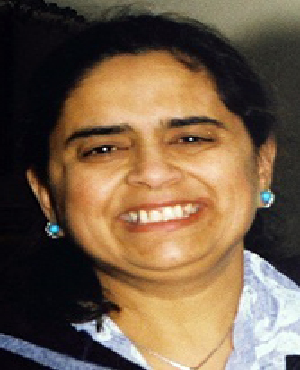 My childhood was mostly normal with one main exception: Since both my parents did theater, I spent a lot of evenings alone at home with domestic help or at the rehearsals with one of them. The weekends again would be spent backstage or dozing in the auditorium. Living in an apartment complex eventually introduced me to lots of friends, whose houses became another good option for weekends. When they toured for plays, I spent a lot of time with my maternal grandparents. While I didn’t see my parents often, being surrounded by people 24/7 definitely gave me a supportive environment to grow up in. Although I grew up in a vibrant theater background, the theater bug did not really bite till much later in life after I met my Husband Chandu Shah, who is also from a similar background.
My childhood was mostly normal with one main exception: Since both my parents did theater, I spent a lot of evenings alone at home with domestic help or at the rehearsals with one of them. The weekends again would be spent backstage or dozing in the auditorium. Living in an apartment complex eventually introduced me to lots of friends, whose houses became another good option for weekends. When they toured for plays, I spent a lot of time with my maternal grandparents. While I didn’t see my parents often, being surrounded by people 24/7 definitely gave me a supportive environment to grow up in. Although I grew up in a vibrant theater background, the theater bug did not really bite till much later in life after I met my Husband Chandu Shah, who is also from a similar background.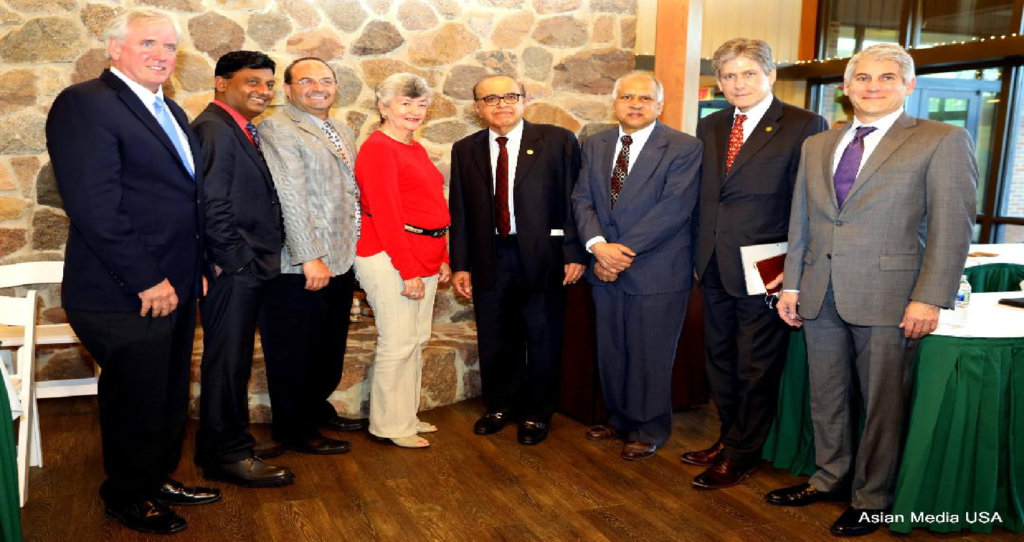 In his acceptance speech, Dr. Reddy said, “As a practicing physician, I will use my training and experiences to ensure that appropriate and effective health policies are approved by the board and implemented by our village staff. There are many expert doctors and medical professionals in our community. I will find ways to engage them through informal work groups or more formal committees if needed to ensure the safety of our residents.”
In his acceptance speech, Dr. Reddy said, “As a practicing physician, I will use my training and experiences to ensure that appropriate and effective health policies are approved by the board and implemented by our village staff. There are many expert doctors and medical professionals in our community. I will find ways to engage them through informal work groups or more formal committees if needed to ensure the safety of our residents.”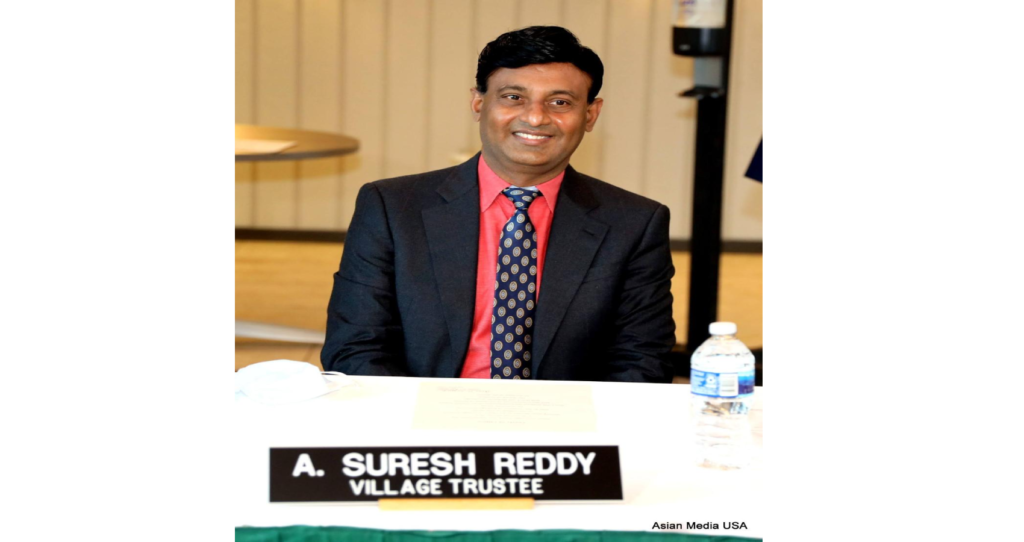 Having a population of nearly 10,000 people, the city of Oak Brook is located 15 miles west of the
Having a population of nearly 10,000 people, the city of Oak Brook is located 15 miles west of the 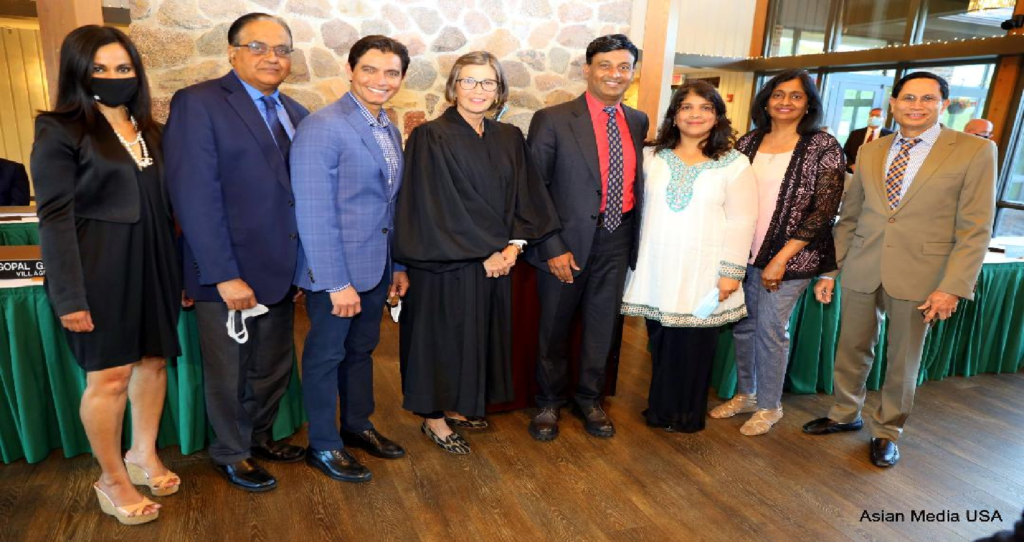 A dynamic leader, Dr. Reddy has devoted a greater part of his life to numerous initiates within the United States , in addition to serving his people back in India, As part of his community service, Dr. Reddy has facilitated and organized numerous health camps and workshops, with special emphasis on CPR training , obesity prevention in conjunction with Chicago Medical Society.
A dynamic leader, Dr. Reddy has devoted a greater part of his life to numerous initiates within the United States , in addition to serving his people back in India, As part of his community service, Dr. Reddy has facilitated and organized numerous health camps and workshops, with special emphasis on CPR training , obesity prevention in conjunction with Chicago Medical Society. Sonal Shah, the foundation’s president, and TAAF board members were at the White House, where they briefed administration officials, including domestic policy adviser Susan Rice. They discussed how the foundation plans to spend the $1.1 billion in donations to fight back against hate crimes directed at these communities, according to a statement from the foundation. Biden and Vice President Kamala Harris dropped by the meeting to express their support, the foundation said.
Sonal Shah, the foundation’s president, and TAAF board members were at the White House, where they briefed administration officials, including domestic policy adviser Susan Rice. They discussed how the foundation plans to spend the $1.1 billion in donations to fight back against hate crimes directed at these communities, according to a statement from the foundation. Biden and Vice President Kamala Harris dropped by the meeting to express their support, the foundation said.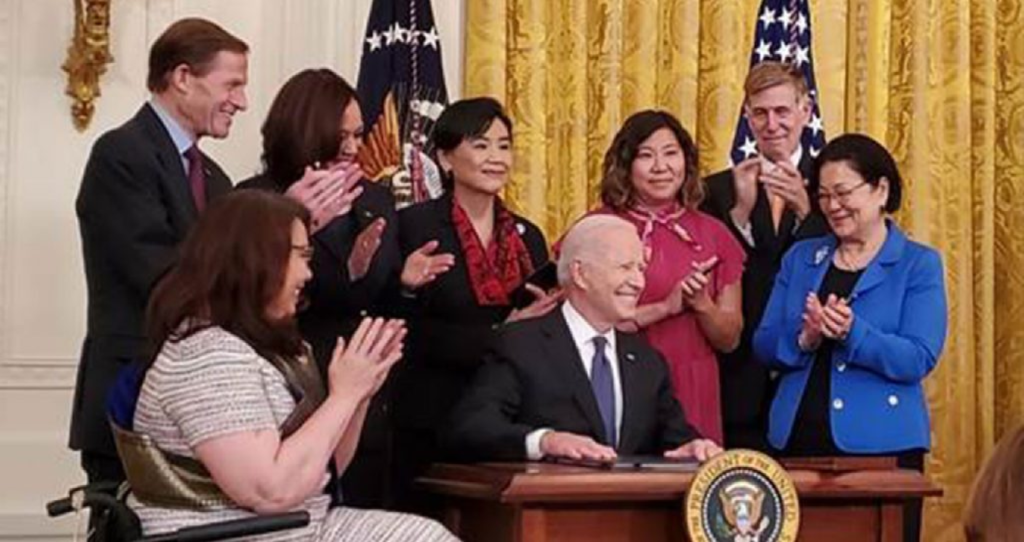 He also welcomed the passage of the Jabara-Heyer NO HATE Act along with the Covid-19 Hate Crime Act that was signed by President Biden. The NO HATE Act was named in honor of two victims, Khalid Jabara and Heather Heyer, whose murders were prosecuted as hate crimes but not appropriately included in hate-crime statistics. “This marks the first necessary step towards resolving the longstanding problem of hate in our nation,” Singh said, referring to the Jabara-Heyer Act. He said it was made possible after years of advocacy by civil rights organizations.
He also welcomed the passage of the Jabara-Heyer NO HATE Act along with the Covid-19 Hate Crime Act that was signed by President Biden. The NO HATE Act was named in honor of two victims, Khalid Jabara and Heather Heyer, whose murders were prosecuted as hate crimes but not appropriately included in hate-crime statistics. “This marks the first necessary step towards resolving the longstanding problem of hate in our nation,” Singh said, referring to the Jabara-Heyer Act. He said it was made possible after years of advocacy by civil rights organizations.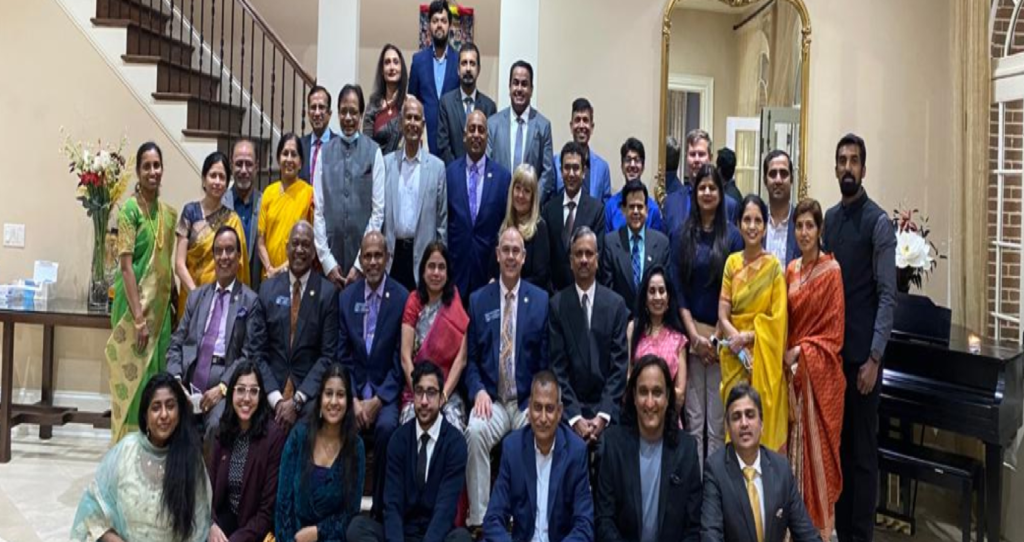 On April 16th, during the meeting, Governor Reeves welcomed IAICC’s initiative to improve the economic situation in the State. Mr. Kumar appreciated the support of Governor Reeves for IAICC and said the Chamber’s partnership with Mississippi will not only benefit businesses across the State but also the adjoining States. Dr. Kulkarni told Governor Reeves that the delegation was very pleased with the meeting and hoped there will be a positive momentum in terms of economic development in Mississippi. She also said that she is looking forward to IAICC and the Mississippi Development Authority (MDA) to coordinate a plan for Governor Reeves to visit India soon.
On April 16th, during the meeting, Governor Reeves welcomed IAICC’s initiative to improve the economic situation in the State. Mr. Kumar appreciated the support of Governor Reeves for IAICC and said the Chamber’s partnership with Mississippi will not only benefit businesses across the State but also the adjoining States. Dr. Kulkarni told Governor Reeves that the delegation was very pleased with the meeting and hoped there will be a positive momentum in terms of economic development in Mississippi. She also said that she is looking forward to IAICC and the Mississippi Development Authority (MDA) to coordinate a plan for Governor Reeves to visit India soon.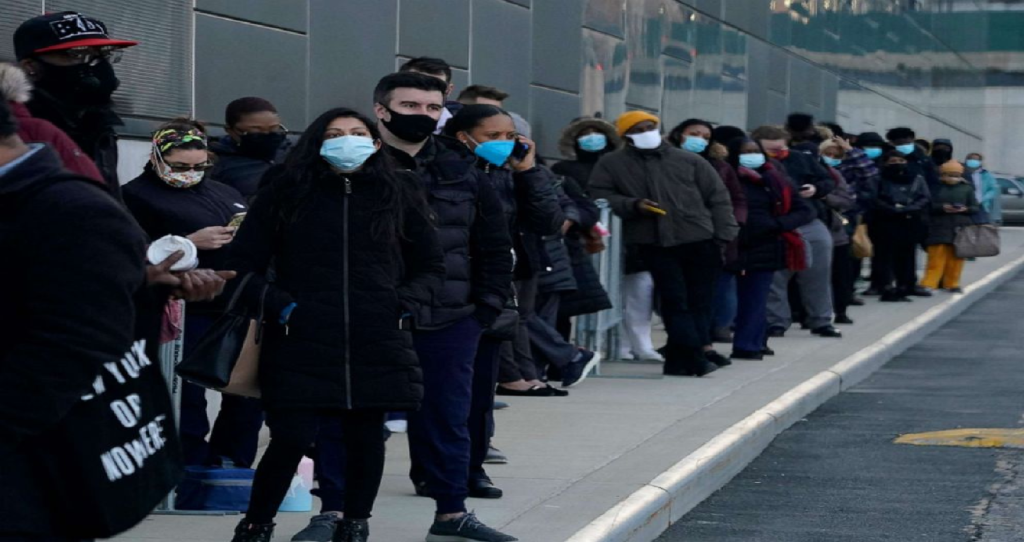 In light of the CDC guidance, the Pentagon announced on Friday that fully vaccinated Defense Department personnel no longer need to wear masks indoors or outdoors at Defense facilities.The CDC and the Biden administration have faced pressure to ease restrictions on fully vaccinated people — those who are two weeks past their last required COVID-19 vaccine dose — in part to highlight the benefits of getting the shots. The country’s aggressive vaccination campaign has paid off:
In light of the CDC guidance, the Pentagon announced on Friday that fully vaccinated Defense Department personnel no longer need to wear masks indoors or outdoors at Defense facilities.The CDC and the Biden administration have faced pressure to ease restrictions on fully vaccinated people — those who are two weeks past their last required COVID-19 vaccine dose — in part to highlight the benefits of getting the shots. The country’s aggressive vaccination campaign has paid off: 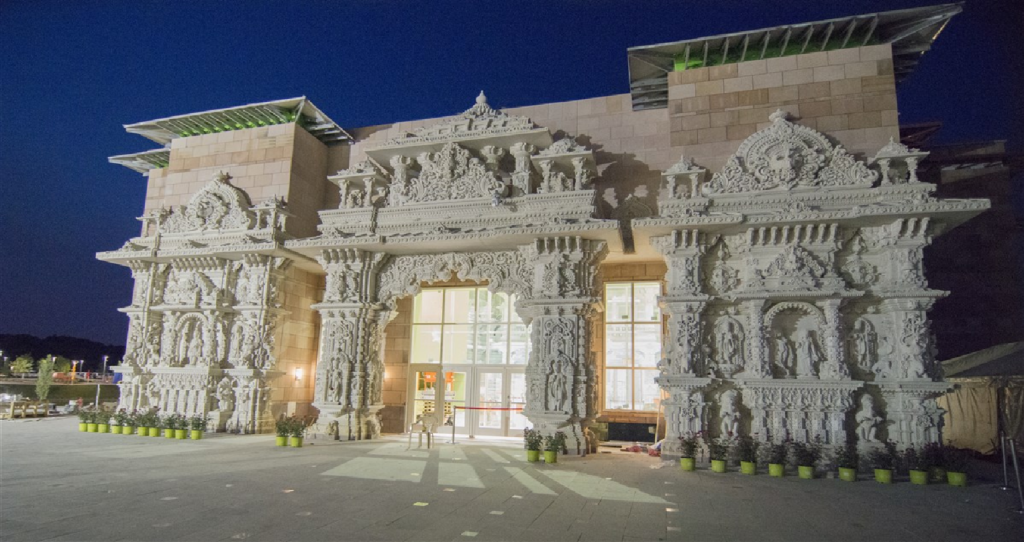 BAPS has been accused of human trafficking and wage law violations. An FBI spokesperson confirmed that agents were at the temple on “court-authorized law enforcement activity,” but wouldn’t elaborate. One of the attorneys who filed the suit said some workers had been removed from the site May 11.The lawsuit has been filed a month after New Jersey labor authorities halted work by a contractor at the Robbinsville temple and at a BAPS temple in Edison. The new lawsuit is a proposed class action complaint, alleging around 200 workers on religious immigration visas endured forced manual labor for the ongoing construction and expansion of the religious property on the 100-acre site.
BAPS has been accused of human trafficking and wage law violations. An FBI spokesperson confirmed that agents were at the temple on “court-authorized law enforcement activity,” but wouldn’t elaborate. One of the attorneys who filed the suit said some workers had been removed from the site May 11.The lawsuit has been filed a month after New Jersey labor authorities halted work by a contractor at the Robbinsville temple and at a BAPS temple in Edison. The new lawsuit is a proposed class action complaint, alleging around 200 workers on religious immigration visas endured forced manual labor for the ongoing construction and expansion of the religious property on the 100-acre site.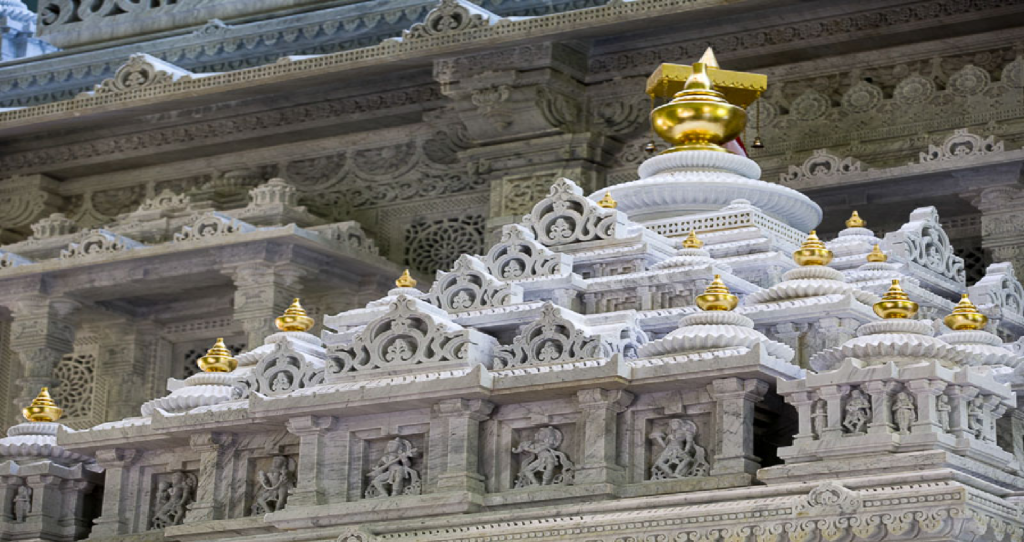 BAPS is a global sect of Hinduism founded in the early 20th century and aims to “preserve Indian culture and the Hindu ideals of faith, unity, and selfless service,” according to its website. The organization says it has built more than 1,100 mandirs — often large complexes that essentially function as community centers. BAPS is known for community service and philanthropy, taking an active role in the diaspora’s initiative to help India amid the current COVID-19 surge. According to the website for the Robbinsville mandir, its construction “is the epitome of volunteerism.”“Volunteers of all ages have devoted their time and resources from the beginning: assisting in the construction work, cleaning up around the site, preparing food for all the artisans on a daily basis and helping with other tasks,” the website says. “A total of 4.7 million man hours were required by craftsman and volunteers to complete the Mandir.”
BAPS is a global sect of Hinduism founded in the early 20th century and aims to “preserve Indian culture and the Hindu ideals of faith, unity, and selfless service,” according to its website. The organization says it has built more than 1,100 mandirs — often large complexes that essentially function as community centers. BAPS is known for community service and philanthropy, taking an active role in the diaspora’s initiative to help India amid the current COVID-19 surge. According to the website for the Robbinsville mandir, its construction “is the epitome of volunteerism.”“Volunteers of all ages have devoted their time and resources from the beginning: assisting in the construction work, cleaning up around the site, preparing food for all the artisans on a daily basis and helping with other tasks,” the website says. “A total of 4.7 million man hours were required by craftsman and volunteers to complete the Mandir.”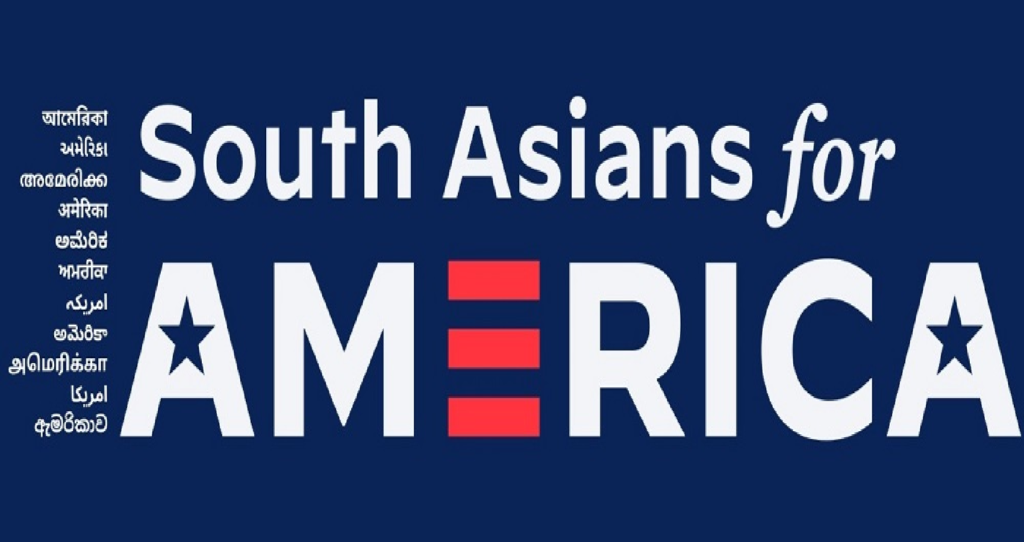 The new organization aims to harness the momentum of its grassroots efforts during the 2020 election, which propelled President Joe Biden and Vice President Kamala Harris to the White House, and flipped the Senate with the wins of Democrats Jon Ossoff and Raphael Warnock in Georgia. SAFA is now aiming to get behind Democratic candidates in the House and Senate who are contesting in the 2022 midterm election.
The new organization aims to harness the momentum of its grassroots efforts during the 2020 election, which propelled President Joe Biden and Vice President Kamala Harris to the White House, and flipped the Senate with the wins of Democrats Jon Ossoff and Raphael Warnock in Georgia. SAFA is now aiming to get behind Democratic candidates in the House and Senate who are contesting in the 2022 midterm election.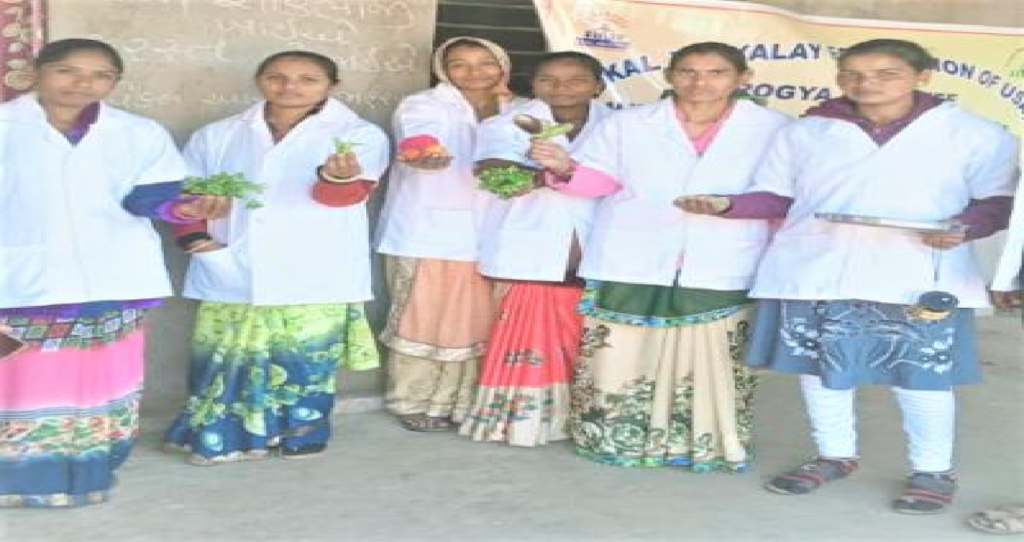 Last year, Ekal’s successful initiative against covid was based on self-monitoring, self-reliance, education and cooperative-exchanges. It included a wide-spread awareness campaign about the hygiene, social distancing, food distribution, mask-making and restrictive movements. The new offensive has not only incorporated all these steps in the direct-action roadmap, but also, has started a proactive counter campaign against the misinformation about the vaccine, the danger posed by covid and voodoo- treatments. With extensive reach well beyond its footings, Ekal has mobilized tens of thousands of its school teachers for this information campaign. ‘Ekal-Arogya (Health Foundation)’ has established 24-hr Telehealth lifeline (# 011 41236457) for professional medical counselling.
Last year, Ekal’s successful initiative against covid was based on self-monitoring, self-reliance, education and cooperative-exchanges. It included a wide-spread awareness campaign about the hygiene, social distancing, food distribution, mask-making and restrictive movements. The new offensive has not only incorporated all these steps in the direct-action roadmap, but also, has started a proactive counter campaign against the misinformation about the vaccine, the danger posed by covid and voodoo- treatments. With extensive reach well beyond its footings, Ekal has mobilized tens of thousands of its school teachers for this information campaign. ‘Ekal-Arogya (Health Foundation)’ has established 24-hr Telehealth lifeline (# 011 41236457) for professional medical counselling.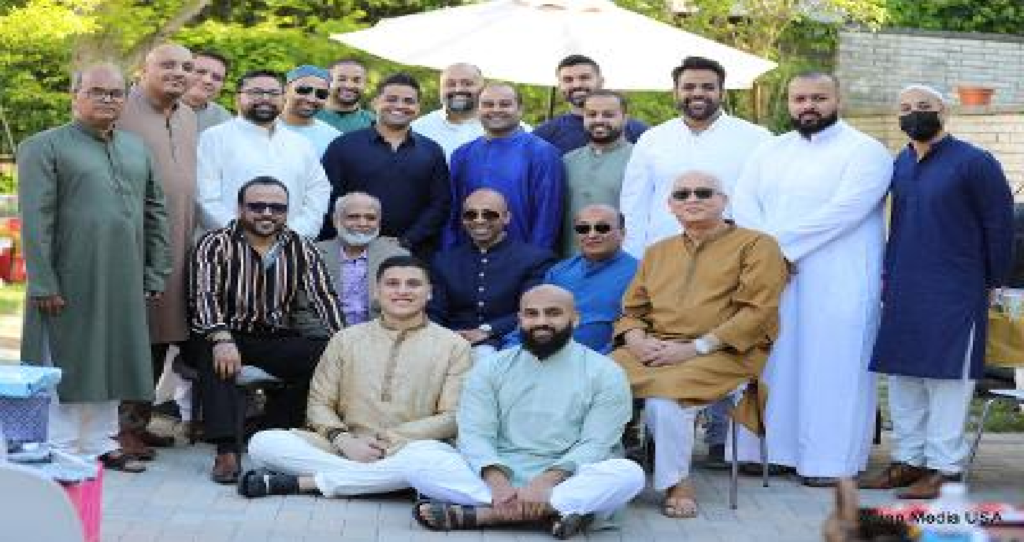 He also pledged that the Indian Americans in Chicago would have grand India Independence Day celebrations and other major Indian festivals such as Diwali, Christmas, and Baisakhi after the departure of the Covid. Joined at the EID reception includes Babu Marsha Patel, Keerthi Kumar Ravoori, SanhitaAgnihotri, Suresh Bodiwala, Satish Dadepogu, Sainath Reddy Boyapalli, BhanuSwargam.Each of them greeted the family of Iftekhar Shareef and thanked the Shareef family for hosting a pleasant EID reception.
He also pledged that the Indian Americans in Chicago would have grand India Independence Day celebrations and other major Indian festivals such as Diwali, Christmas, and Baisakhi after the departure of the Covid. Joined at the EID reception includes Babu Marsha Patel, Keerthi Kumar Ravoori, SanhitaAgnihotri, Suresh Bodiwala, Satish Dadepogu, Sainath Reddy Boyapalli, BhanuSwargam.Each of them greeted the family of Iftekhar Shareef and thanked the Shareef family for hosting a pleasant EID reception.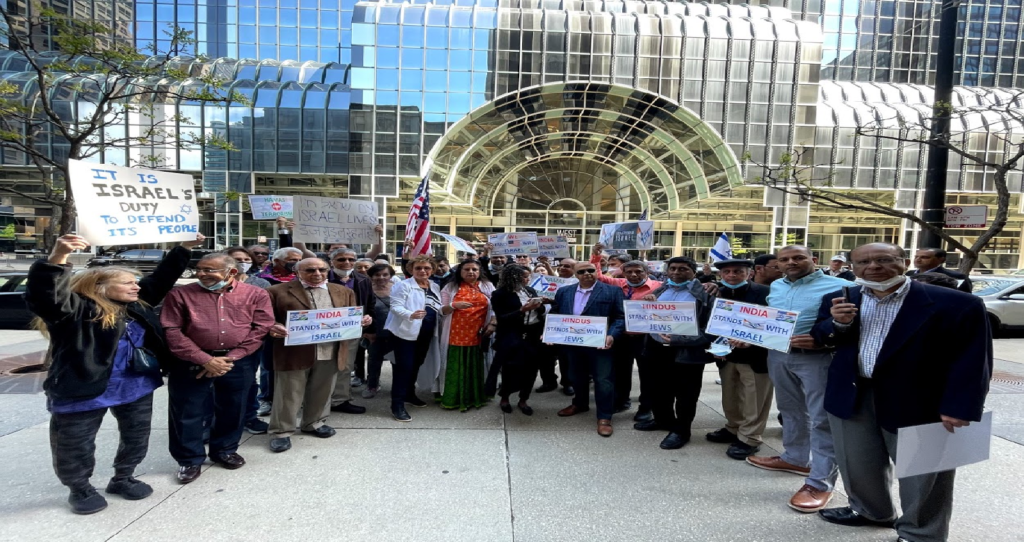 Hindu American community leader Dr. Barai addressed the gathering and said that they are here today to stand with the people of Israel who are targeted by constant rocket attacks from Gaza. He also said that Hamas terrorists have not only destroyed houses and killed innocent civilians in the state of Israel but are also terrorizing people of Gaza. After decades of experiencing wars, people of Israel and Gaza deserve to live in peace, and Dr. Barai expressed the solid commitment of the Hindu community to continue supporting Israel and the demand for peace in the region through this difficult situation.
Hindu American community leader Dr. Barai addressed the gathering and said that they are here today to stand with the people of Israel who are targeted by constant rocket attacks from Gaza. He also said that Hamas terrorists have not only destroyed houses and killed innocent civilians in the state of Israel but are also terrorizing people of Gaza. After decades of experiencing wars, people of Israel and Gaza deserve to live in peace, and Dr. Barai expressed the solid commitment of the Hindu community to continue supporting Israel and the demand for peace in the region through this difficult situation.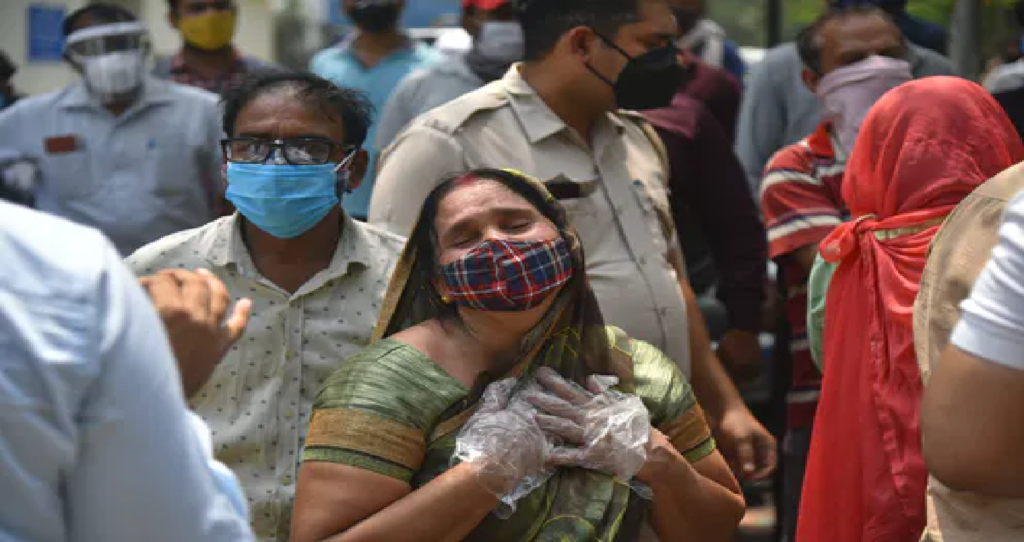 “Firstly, every NGO in the country had to set up an FCRA designated account at the main branch of State Bank of India in New Delhi to receive all foreign donations. Earlier, donations could be received in any bank where the NGO had a designated FCRA account.
“Firstly, every NGO in the country had to set up an FCRA designated account at the main branch of State Bank of India in New Delhi to receive all foreign donations. Earlier, donations could be received in any bank where the NGO had a designated FCRA account.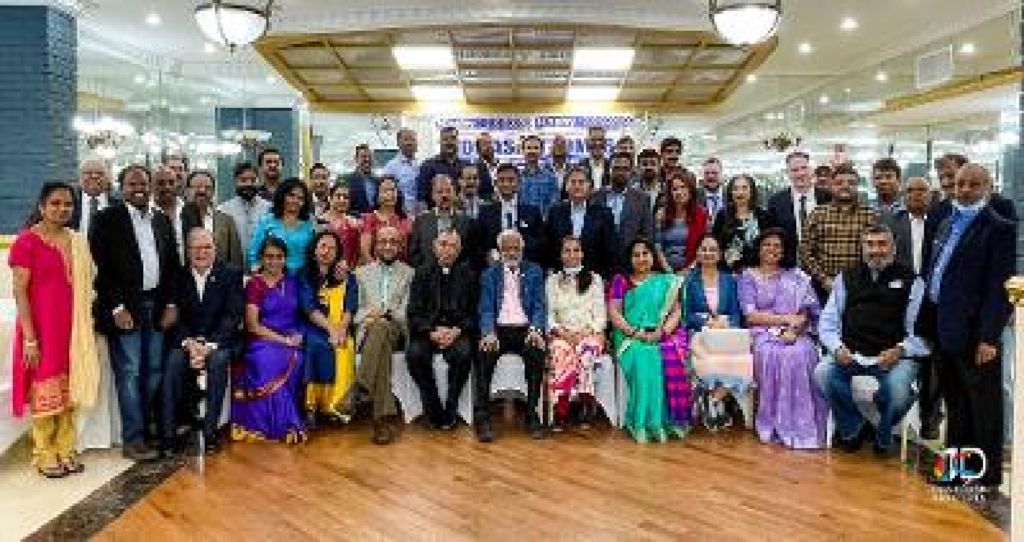 Those who participated in the prayer include Guru jiGarud Gopal Prabhu, Father John Thomas of Jackson Heights Orthodox Church, Imam Muhammad Waliullah of Hillside Islamic Center, Ashok Vyas of ITV, Hemanth Shah of FBIMA, Suhag Mehta of Ganesh Utsav, Kripal Singh, VirendraVora, Paul Karukapally, Ashok Vora, Philipose Philip, V.M. Chacko, Varghese Abraham, Mercedes Buchanan and George Abraham of IOCUSA.
Those who participated in the prayer include Guru jiGarud Gopal Prabhu, Father John Thomas of Jackson Heights Orthodox Church, Imam Muhammad Waliullah of Hillside Islamic Center, Ashok Vyas of ITV, Hemanth Shah of FBIMA, Suhag Mehta of Ganesh Utsav, Kripal Singh, VirendraVora, Paul Karukapally, Ashok Vora, Philipose Philip, V.M. Chacko, Varghese Abraham, Mercedes Buchanan and George Abraham of IOCUSA.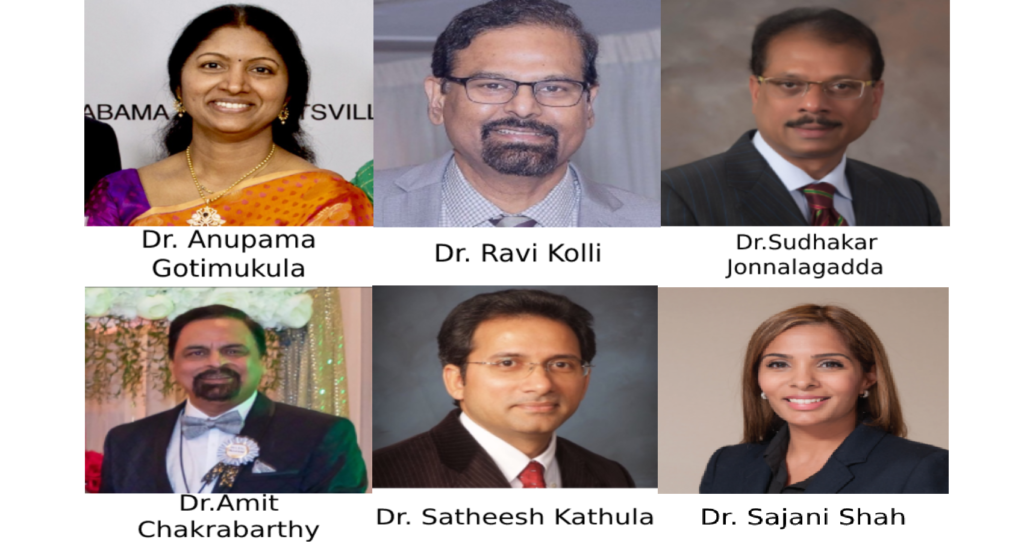 the US and back home in India, spearheading numerous initiatives to help, guide and support the people and the physician community in India on ways to combat and overcome the deadly virus.
the US and back home in India, spearheading numerous initiatives to help, guide and support the people and the physician community in India on ways to combat and overcome the deadly virus.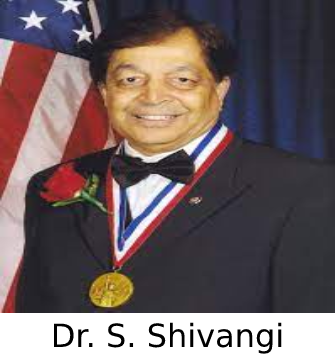 In the letters sent to the 100 US Senators, while acknowledging the respect and influence each of them command on Capitol Hill, Dr. Shivangi said, “we seek your strongest effort to convince the White House to permit more vaccine raw material to be released immediately for local vaccine production, as well as increasing all types of assistance, in a catastrophe of such magnitude.”
In the letters sent to the 100 US Senators, while acknowledging the respect and influence each of them command on Capitol Hill, Dr. Shivangi said, “we seek your strongest effort to convince the White House to permit more vaccine raw material to be released immediately for local vaccine production, as well as increasing all types of assistance, in a catastrophe of such magnitude.”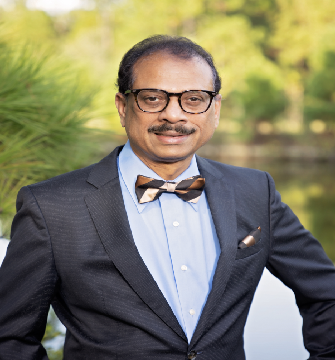 “We are continuing to interact with the physicians back in India to answer their questions. AAPI as a group and individual physicians are reaching out almost on a daily basis with doctors on ground in India,” Dr. Ravi Kolli, Vice President of AAPI said, adding that it is in addition to the calls being received from their friends and families back home.
“We are continuing to interact with the physicians back in India to answer their questions. AAPI as a group and individual physicians are reaching out almost on a daily basis with doctors on ground in India,” Dr. Ravi Kolli, Vice President of AAPI said, adding that it is in addition to the calls being received from their friends and families back home.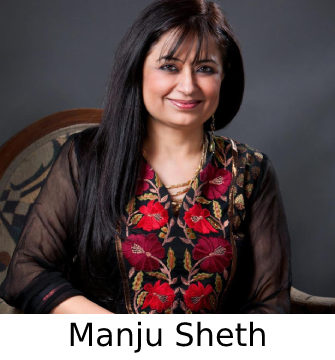 Ms. Banerjee is an award-winning and bestselling author, poet, activist and teacher of writing. Her work has been published in over 50 magazines, including the
Ms. Banerjee is an award-winning and bestselling author, poet, activist and teacher of writing. Her work has been published in over 50 magazines, including the 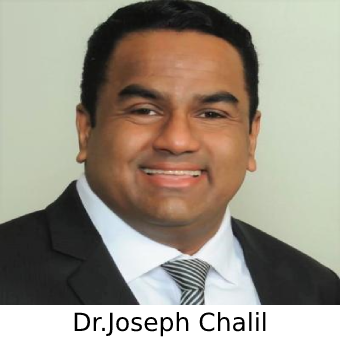 India has a daily production capacity of at least 7,100 tons of oxygen, including for industrial use, which appears to be more than enough to meet current demand. The problem is not a shortage of medical oxygen but the supply chain of delivering it to the patient bedside in a hospital. A routine site at all major Indian hospitals is the large oxygen cylinders delivering oxygen to patients at the bedside. Yet this is something you never see in a western hospital. All American hospitals have central piping, which delivers oxygen to the patient bedside from a Pressure Swing Adsorption (PSA) Oxygen Plant attached to each hospital. This is one of the building permit requirements for a new hospital in the USA. Medical oxygen can easily be manufactured from surrounding air.
India has a daily production capacity of at least 7,100 tons of oxygen, including for industrial use, which appears to be more than enough to meet current demand. The problem is not a shortage of medical oxygen but the supply chain of delivering it to the patient bedside in a hospital. A routine site at all major Indian hospitals is the large oxygen cylinders delivering oxygen to patients at the bedside. Yet this is something you never see in a western hospital. All American hospitals have central piping, which delivers oxygen to the patient bedside from a Pressure Swing Adsorption (PSA) Oxygen Plant attached to each hospital. This is one of the building permit requirements for a new hospital in the USA. Medical oxygen can easily be manufactured from surrounding air. AirSep Corporation of New York has installed PSA Medical Oxygen Systems in more than 4,500 hospitals in nearly 50 countries worldwide, including several hospitals in India, to meet their central pipeline and other oxygen needs. These generators and plants operate automatically to supply patient, surgical, and critical care units in medical facilities, military field hospitals, on-site emergency preparedness centers, and disaster-relief efforts. There are several other manufacturers with similar technologies.
AirSep Corporation of New York has installed PSA Medical Oxygen Systems in more than 4,500 hospitals in nearly 50 countries worldwide, including several hospitals in India, to meet their central pipeline and other oxygen needs. These generators and plants operate automatically to supply patient, surgical, and critical care units in medical facilities, military field hospitals, on-site emergency preparedness centers, and disaster-relief efforts. There are several other manufacturers with similar technologies. Let this be the Last Medical Oxygen Crisis in India. Let us not scramble our resources; purchasing compressed liquid oxygen from Russia or China, which at best is a temporary fix but will arrive too late for our patients’ bedside in Delhi. Let us retrofit our hospitals with central oxygen piping
Let this be the Last Medical Oxygen Crisis in India. Let us not scramble our resources; purchasing compressed liquid oxygen from Russia or China, which at best is a temporary fix but will arrive too late for our patients’ bedside in Delhi. Let us retrofit our hospitals with central oxygen piping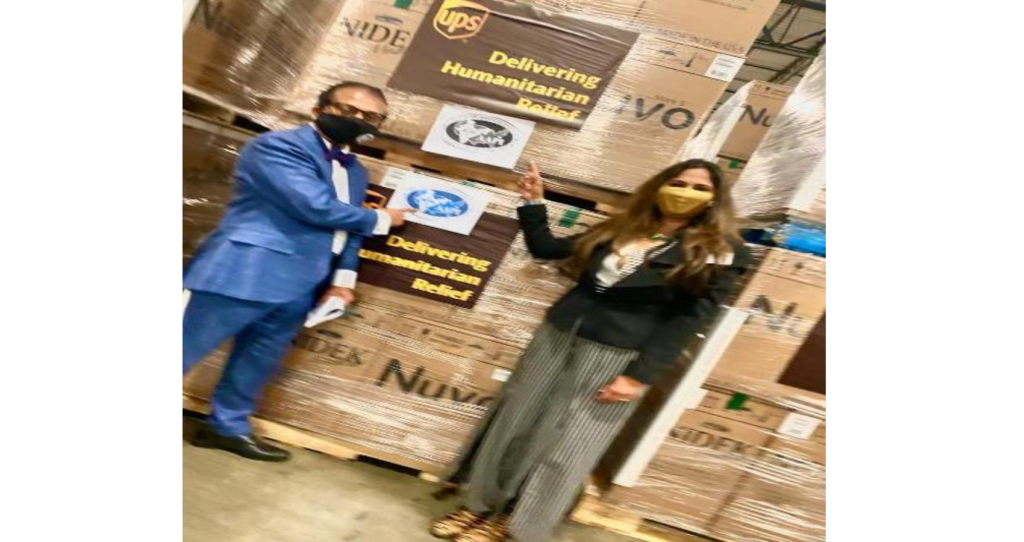 “On behalf of AAPI leadership, we would like to have a series of educational messages to the communities on Covid to address the concerns of the public and medical community during the pandemic time as we recognize our role is to educate communities. Through this voluntary project from our members, we can help educate the people first. Allay their fears. Explain and educate them about the disease and on ways to combat the virus.”
“On behalf of AAPI leadership, we would like to have a series of educational messages to the communities on Covid to address the concerns of the public and medical community during the pandemic time as we recognize our role is to educate communities. Through this voluntary project from our members, we can help educate the people first. Allay their fears. Explain and educate them about the disease and on ways to combat the virus.”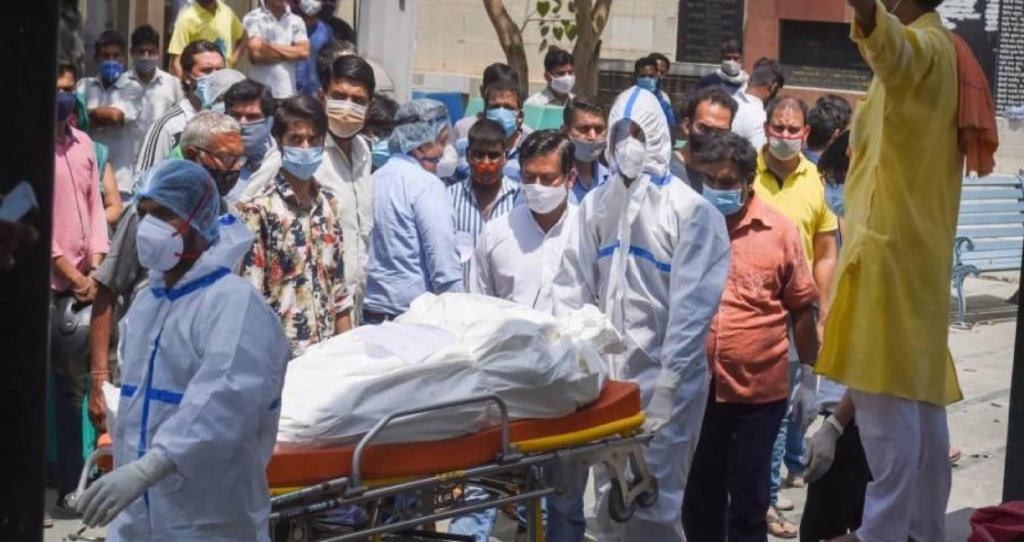 Maharashtra reported 62,919 infections, followed by Karnataka (48,296), and Kerala (37,199). Maharashtra also recorded 828 casualties, followed by Delhi (375) and Uttar Pradesh (332). The country has so far reported a total of 1,91,63,488 cases and 2,11,778 deaths.
Maharashtra reported 62,919 infections, followed by Karnataka (48,296), and Kerala (37,199). Maharashtra also recorded 828 casualties, followed by Delhi (375) and Uttar Pradesh (332). The country has so far reported a total of 1,91,63,488 cases and 2,11,778 deaths. ASEI Michigan chapter president Muthu Sivanantham introduced and facilitated discussion with the next two speakers. Dr Raj Ramesh, a TEDx speaker who happens to have a doctorate in AI was the next author to speak. He has broad experience with digital transformation and helps organizations bring together complementary strengths of machines and humans to effect grand change. His talk featuring interesting doodles and interactive audience participation surveys was patterned on his recent book, “AI & You” and he advised how to co-exist with machines by sharing how to think, thrive, and transform in an AI driven future.
ASEI Michigan chapter president Muthu Sivanantham introduced and facilitated discussion with the next two speakers. Dr Raj Ramesh, a TEDx speaker who happens to have a doctorate in AI was the next author to speak. He has broad experience with digital transformation and helps organizations bring together complementary strengths of machines and humans to effect grand change. His talk featuring interesting doodles and interactive audience participation surveys was patterned on his recent book, “AI & You” and he advised how to co-exist with machines by sharing how to think, thrive, and transform in an AI driven future.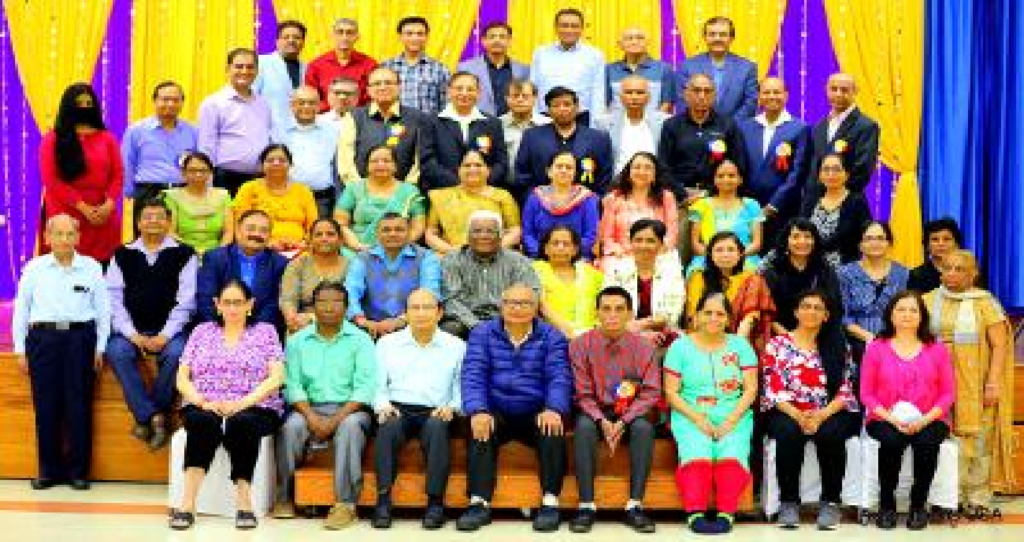 The Appreciation letter from the Governor concluded: “On behalf of the people of the State of Illinois, it is my pleasure to thank you for your ongoing work of Vaccination. Your dedication and leadership have created a lasting impact in your community and you have been an asset to all of Illinois in our collaboration to overcome the Pandemic. “J.B. Pritzker, Hon. Governor of Illinois.
The Appreciation letter from the Governor concluded: “On behalf of the people of the State of Illinois, it is my pleasure to thank you for your ongoing work of Vaccination. Your dedication and leadership have created a lasting impact in your community and you have been an asset to all of Illinois in our collaboration to overcome the Pandemic. “J.B. Pritzker, Hon. Governor of Illinois.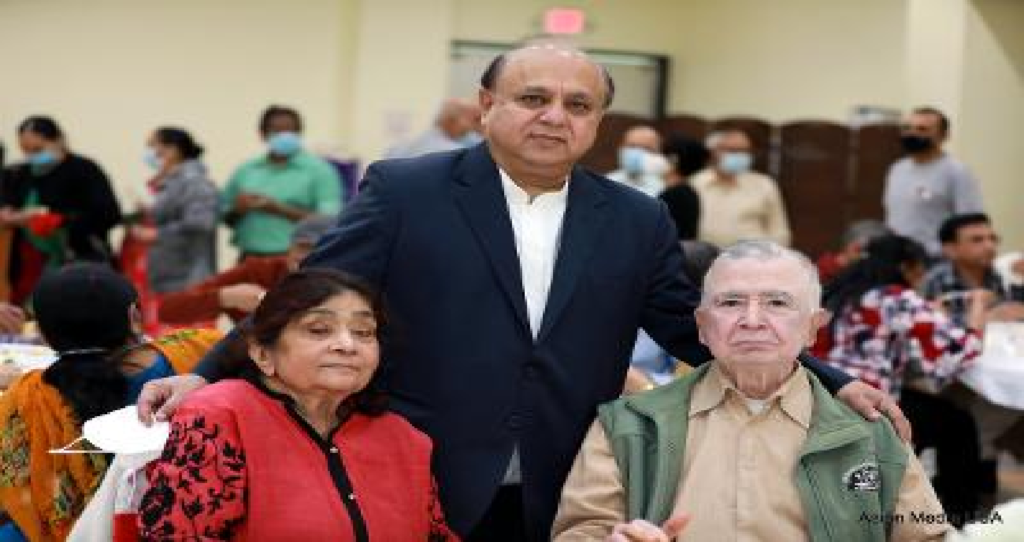 Dr Kapadia and his wife Seema Kapadia thanked each member of the team including Gujarati Seniors of Chicago team who made the vaccination camp a huge success. Dr Kapadia mentioned how his wife Seema Kapadia and his sons have been a driving force behind all these campaigns to ensure smooth execution. He added that Ms. Seema Kapadia has been present at many vaccination camps from the beginning till the end to ensure a safe, timely and equitable administration of the vaccine.
Dr Kapadia and his wife Seema Kapadia thanked each member of the team including Gujarati Seniors of Chicago team who made the vaccination camp a huge success. Dr Kapadia mentioned how his wife Seema Kapadia and his sons have been a driving force behind all these campaigns to ensure smooth execution. He added that Ms. Seema Kapadia has been present at many vaccination camps from the beginning till the end to ensure a safe, timely and equitable administration of the vaccine.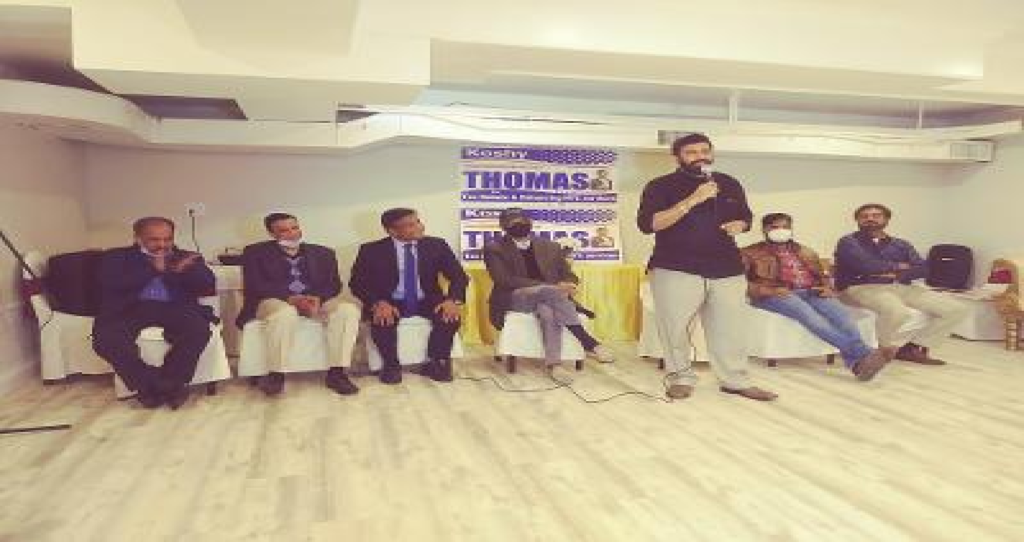 Aniayan George, President of FOMAA (Federation Of Malayalee Associations of Americas), characterized Koshy Thomas as someone who identifies with the community regardless of their background and someone who has the energy, willingness, and capacity to elevate his contributions further as an NYC Councilman. “ I believe Koshy Thomas can win this election, and he will be our first Asian Indian representation in the City Council,” he added.
Aniayan George, President of FOMAA (Federation Of Malayalee Associations of Americas), characterized Koshy Thomas as someone who identifies with the community regardless of their background and someone who has the energy, willingness, and capacity to elevate his contributions further as an NYC Councilman. “ I believe Koshy Thomas can win this election, and he will be our first Asian Indian representation in the City Council,” he added.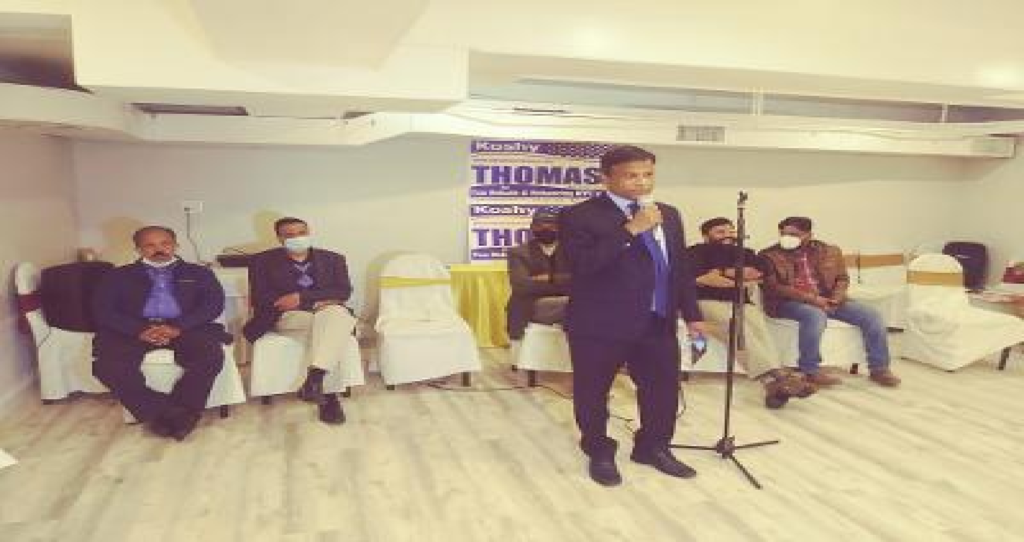 V.M. Chacko, a leading community activist in Queens over four decades, pointed out the potential the community has in this upcoming election and said, “this is not the time to be lackadaisical, and please get involved for the sake of the safety and wellbeing of our community.” Mr. V. Abraham (Raju) described the success the campaign has had in terms of timely submission of the nomination forms and increased awareness of Koshy’s candidacy across the District. Mr. George Parampil, who has been urging Koshy Thomas to run over the years, applauded his dedication to the community and threw his full support behind him.
V.M. Chacko, a leading community activist in Queens over four decades, pointed out the potential the community has in this upcoming election and said, “this is not the time to be lackadaisical, and please get involved for the sake of the safety and wellbeing of our community.” Mr. V. Abraham (Raju) described the success the campaign has had in terms of timely submission of the nomination forms and increased awareness of Koshy’s candidacy across the District. Mr. George Parampil, who has been urging Koshy Thomas to run over the years, applauded his dedication to the community and threw his full support behind him. “India is in the ICU and those who put her there now spend their time trying to shift the blame. The change from ‘victory’ over Covid to gasping for oxygen began in the last week of January this year when the Prime Minister proudly declared that India had not only defeated the
“India is in the ICU and those who put her there now spend their time trying to shift the blame. The change from ‘victory’ over Covid to gasping for oxygen began in the last week of January this year when the Prime Minister proudly declared that India had not only defeated the 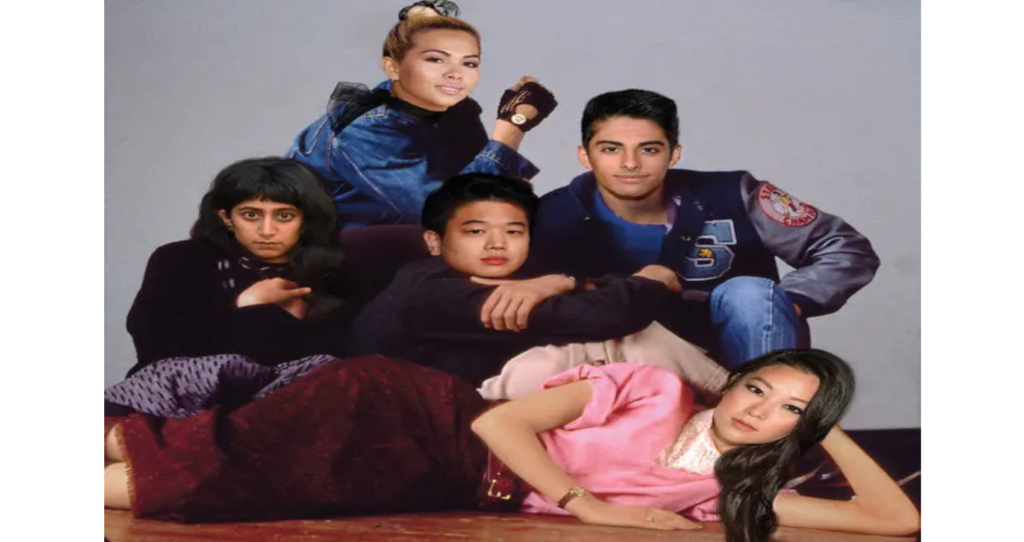 In many ways, Asian Americans are a perfect metaphor for understanding the American experience in the 21st century. A
In many ways, Asian Americans are a perfect metaphor for understanding the American experience in the 21st century. A 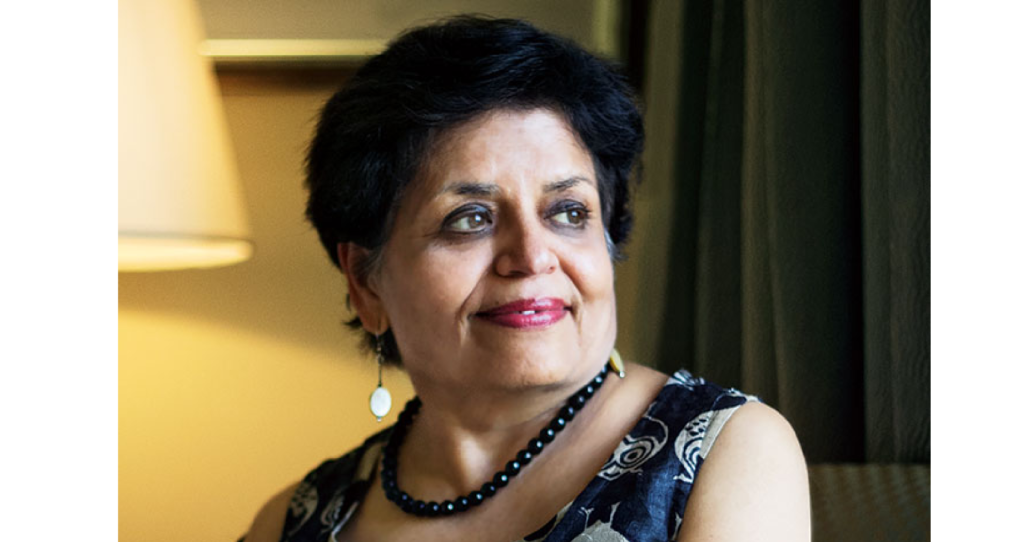 When I joined Asia Society in 1990 as director of the Asia Society Museum, I was the first department head of Asian origin — there was only one other Asian American person in the senior ranks. We made up lost ground in the succeeding decade by developing an institution-wide initiative to increase Asian American programs, audiences, staff, and board members. With a large grant from the Wallace Foundation, we were also able to develop a robust plan for the study and assessment of Asian American views of the institution. It was shocking, if not surprising, to hear that many Asian Americans didn’t feel welcome to the Park Avenue-based institution before, but were beginning to feel the effects of the changes we were making. “We thought Asia Society was really for white people’s experience of Asia, as an exotic and far way place, not for people like us who may mess up their idea of an unadulterated and pure Asia,” one viewer said.
When I joined Asia Society in 1990 as director of the Asia Society Museum, I was the first department head of Asian origin — there was only one other Asian American person in the senior ranks. We made up lost ground in the succeeding decade by developing an institution-wide initiative to increase Asian American programs, audiences, staff, and board members. With a large grant from the Wallace Foundation, we were also able to develop a robust plan for the study and assessment of Asian American views of the institution. It was shocking, if not surprising, to hear that many Asian Americans didn’t feel welcome to the Park Avenue-based institution before, but were beginning to feel the effects of the changes we were making. “We thought Asia Society was really for white people’s experience of Asia, as an exotic and far way place, not for people like us who may mess up their idea of an unadulterated and pure Asia,” one viewer said.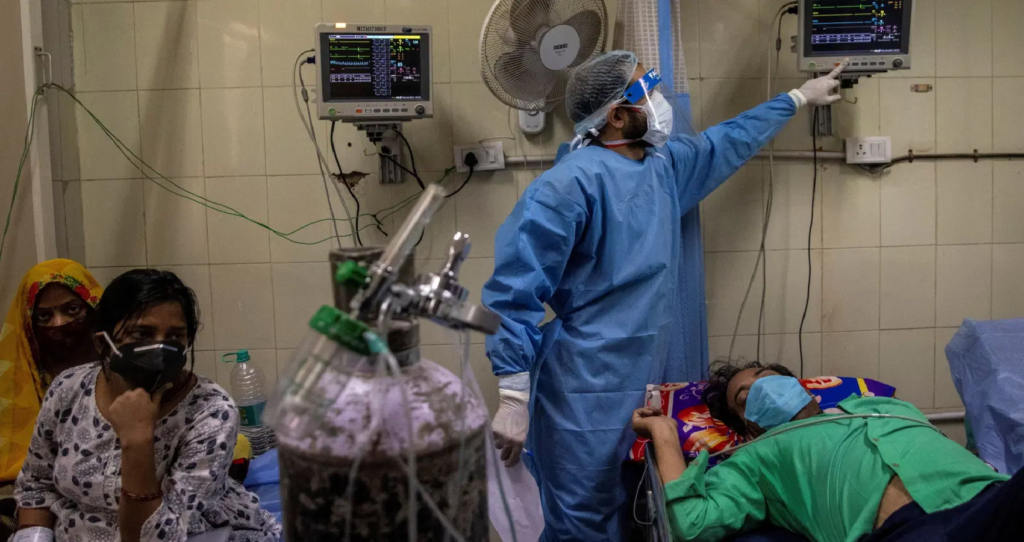 India has now recorded more than 15 million infections and more than 178,000 deaths. Experts agree that even these figures are likely undercounts. New Delhi imposed a weeklong lockdown Monday night to prevent the collapse of the Indian capital’s health system, which authorities said had been pushed to its limit amid an explosive surge in coronavirus cases.
India has now recorded more than 15 million infections and more than 178,000 deaths. Experts agree that even these figures are likely undercounts. New Delhi imposed a weeklong lockdown Monday night to prevent the collapse of the Indian capital’s health system, which authorities said had been pushed to its limit amid an explosive surge in coronavirus cases.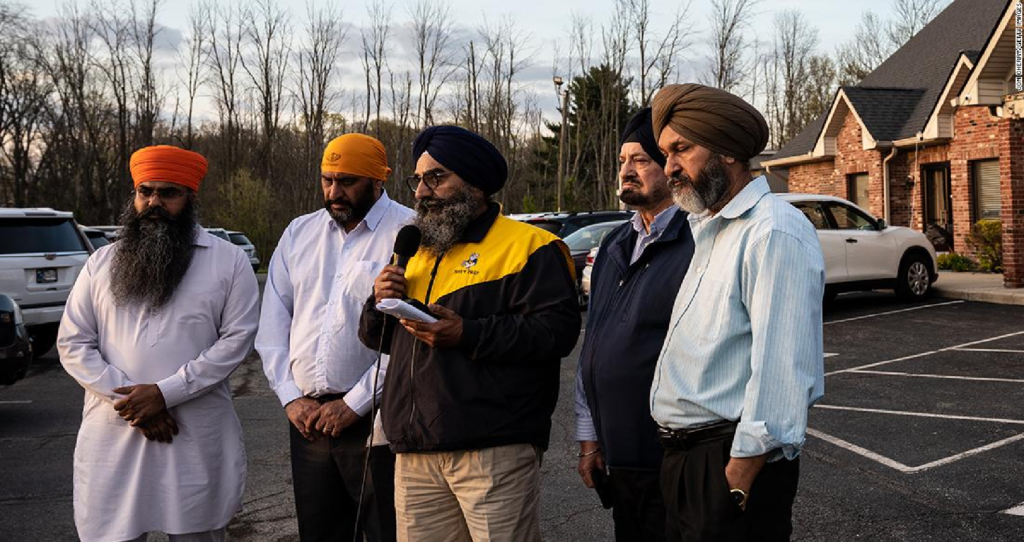 “We will invest significant resources into toppling those who seek to destroy our families, communities, and identity. The senseless gun violence that we’re seeing in this country is reflective of all of the spineless politicians who are beholden to the gun lobby. Period. End of story,” said Nikore. “They will be hearing from us — instead of offering thoughts and prayers, it’s time to mobilize for direct action and vote them out. That is what we’re doing today. We will end the violence, only when we have leaders who have the guts to do so.”
“We will invest significant resources into toppling those who seek to destroy our families, communities, and identity. The senseless gun violence that we’re seeing in this country is reflective of all of the spineless politicians who are beholden to the gun lobby. Period. End of story,” said Nikore. “They will be hearing from us — instead of offering thoughts and prayers, it’s time to mobilize for direct action and vote them out. That is what we’re doing today. We will end the violence, only when we have leaders who have the guts to do so.”